Billion Electric BIL-8920NE The Ultimate Residential Gateway User Manual
Billion Electric Co., Ltd. The Ultimate Residential Gateway Users Manual
Users Manual

Last revised: April 16, 2013
BEC 8920NE
The Ultimate Residental Gateway
User Manual
Version release: v1.01
TABLE OF CONTENTS
CHAPTER 1: INTRODUCTION ....................................1
I
NTRODUCTION TO
Y
OUR
R
OUTER
........................................................... 1
F
EATURES
&
S
PECIFICATIONS
.................................................................. 2
H
ARDWARE
S
PECIFICATIONS
................................................................... 6
A
PPLICATIONS
D
IAGRAM
....................................................................... 6
CHAPTER 2: PRODUCT OVERVIEW ...........................7
I
MPORTANT NOTE FOR USING THIS ROUTER
................................................ 7
P
ACKAGE
C
ONTENTS
............................................................................. 7
D
EVICE
D
ESCRIPTION
............................................................................ 8
The Front LEDs ............................................................................................... 8
The Rear Ports ............................................................................................... 9
C
ABLING
............................................................................................ 9
CHAPTER 3: BASIC INSTALLATION .......................... 10
N
ETWORK
C
ONFIGURATION
................................................................. 11
Configuring a PC in Windows 7 .....................................................................11
Configuring a PC in Windows Vista ...............................................................13
Configuring a PC in Windows XP ...................................................................15
Configuring a PC in Windows 2000 ...............................................................16
Configuring PC in Windows 98/Me ...............................................................17
Configuring PC in Windows NT4.0 .................................................................18
F
ACTORY
D
EFAULT
S
ETTINGS
................................................................ 19
I
NFORMATION FROM YOUR
ISP ............................................................. 20
C
ONFIGURING WITH YOUR
W
EB
B
ROWSER
.............................................. 21
CHAPTER 4: BASIC CONFIGURATION ...................... 22
S
TATUS
........................................................................................... 23
WAN Info .......................................................................................................24
Statistics ........................................................................................................25
LAN ............................................................................................................................ 25
WAN Service............................................................................................................... 25
xTM ............................................................................................................................ 26
xDSL ........................................................................................................................... 27
Route Table ................................................................................................................ 28
ARP Table ................................................................................................................... 29
DHCP Table ................................................................................................................ 29
System Log ................................................................................................................. 29
C
ONFIGURATION
............................................................................... 30
LAN - Local Area Network .............................................................................30
WAN - Wide Area Network ...........................................................................32
Layer2 Interface ......................................................................................................... 32
WAN Service .............................................................................................................. 34
DSL ............................................................................................................................. 42
S
YSTEM
........................................................................................... 43
Time Zone .....................................................................................................43
Firmware Upgrade ........................................................................................44
Backup / Restore ...........................................................................................44
Restart ..........................................................................................................45
User Management ........................................................................................46
F
IREWALL
......................................................................................... 47
IP Filtering .....................................................................................................47
MAC Filtering ............................................................................................................. 50
Q
O
S
-
Q
UALITY OF
S
ERVICE
.................................................................. 52
Queue Config ................................................................................................52
QoS Classification ..........................................................................................53
V
IRTUAL
S
ERVER
................................................................................ 56
Port Mapping ................................................................................................57
DMZ Host ......................................................................................................58
A
DVANCED
....................................................................................... 59
Routing..........................................................................................................59
Default Gateway ...........................................................................................59
Static Route ...................................................................................................59
RIP .................................................................................................................60
DNS ............................................................................................... 60
DNS Server ....................................................................................................60
Dynamic DNS ................................................................................................61
I
NTERFACE
G
ROUPING
........................................................................ 62
D
EVICE
M
ANAGEMENT
....................................................................... 64
Installing UPnP in Windows Example ......................................................................... 64
Auto-discover Your UPnP-enabled Network Device .................................................... 66
Web Configurator Easy Access ................................................................................... 68
System Log Server .........................................................................................69
TR-069 Client .................................................................................................70
D
IAGNOSTICS
.................................................................................... 71
Diagnostics ....................................................................................................71
Fault Management ........................................................................................72
CHAPTER 5: TROUBLESHOOTING ........................... 73
APPENDIX: PRODUCT SUPPORT & CONTACT ......... 74
1
Chapter 1: Introduction
Introduction to Your Router
Thank you for purchasing BEC 8920NE The Ultimate Residential Gateway. The BEC 8920NE is
an all-in-one Universal Bonded Gateway supporting ultra-broadband triple-play services via multiple
WAN connection options. Service providers can utilize one gateway for all major broadband
technologies such ADSL2+, VDSL2, xDSL bonding and FTTH. In addition to offering the multiple
WAN connection options, the 8920NE integrates multiport Ethernet switching and routing, 802.11n
Wireless networking, advanced firewall security including stateful packet inspection, Quality of
Service (QoS) and remote management. Users can easily enjoy high bandwidth services such as
High Definition IPTV, streaming video, interactive gaming, over-the-top (OTT) applications to
multiple devices throughout the home.
Flexible Deployment Options
The BEC 8920NE provides service operators with flexible, scalable deployment options optimized to
both reduce costs and provide the longest possible lifespan for the investment. The BEC 8920NE
integrates dual WAN options; a VDSL2/ADSL2+ interface and a second 10/100/1000 Ethernet WAN
interface which can be used for broadband connectivity to any other Ethernet broadband device.
Operators can now deploy one device to support current and future network migration.
Quality of Service
Quality of Service (QoS) gives users’ full control over outgoing data traffic. Priority can be assigned
by the router to ensure that important transmissions like gaming packets, VoIP calls or
IPTV/streaming content passes through the router at lightning speed, even when there is heavy
Internet traffic. The speed of different types of outgoing data passing through the gateway is also
controlled to ensure that users do not saturate bandwidth with their browsing activities.
Robust Firewall Security
The NAT default firewall has advanced anti-hacker pattern-filtering protection features that
automatically detect and block Denial of Service (DoS) attacks. In addition, Packet Filtering provides
high-level security for access control. Built with Stateful Packet Inspection (SPI), the router enables
users to determine whether or not a data packet is allowed to pass through the firewall to the private
LAN.
Optimal Wireless Speed and Coverage
With an integrated 802.11n Wireless Access Point, the router delivers up to 6 times the speed and 3
times the wireless coverage of an 802.11b / g network device. It supports a link rate up to 300Mbps
and is also compatible with 802.11b/g equipment. The Wireless Protected Access
(WPA-PSK/WPA2-PSK) and Wireless Encryption Protocol (WEP) features enhance the level of
transmission security and access control over Wireless LAN. The router also supports the Wi-Fi
Protected Setup (WPS) standard for easy and secure establishment of a wireless home network. If
the user’s network requires wider coverage, the built-in Wireless Distribution System (WDS)
repeater function expands the wireless network without needing any external wires or cables.
2
Pathway to the Future
The BEC 8920NE fully supports IPv6 (Internet Protocol Version 6), implementation of IPv6 is
growing significantly and multiple transition methods are required to support the coexistence and
migration from IPv4. With BEC IPv6 enabled devices, service providers easily adapt IPv6 to their
network as we support major transition mechanisms such as Dual-Stack, Dual-Stack Lite, and 6RD.
Features & Specifications
VDSL Compliance
• Compliant with ITU-T G.993.2, G.994.1 and G.997.1 VDSL2 Standard
• VDSL2 Profiles for one line: 8a, 8b, 8c.8d,12a,12b, 17a
• VDSL2 Profiles for two line: 8a, 8b, 8c.8d,12a, 12b
• ADSL/2/2+ fallback modes
• Comply G.993.5, G.998.2 and G.998.4
ADSL Compliance
• Compliant with ADSL Standards
- Full-rate ANSI T1.413 Issue 2
- G.dmt (ITU G.992.1)
- G.lite (ITU G.992.2)
- G.hs (ITU G.994.1)
• Compliant with ADSL2 Standards
- G.dmt.bis (ITU G.992.3)
- ADSL2 Annex M (ITU G.992.3 Annex M)
• Compliant with ADSL2+ Standards
- G.dmt.bis plus (ITU G.992.5)
• Comply ITU T G.998.1 and G.998.2
Network Protocols and Features
• NAT, static routing and RIP-1/2
• Universal Plug and Play (UPnP) Compliant
• Transparent Bridging
• Dynamic Domain Name System (DDNS)
• Virtual Server and DMZ
• SNTP, DNS relay and IGMP proxy
• VLAN_MUX and IGMP snooping for video service
• Management based-on IP protocol, port number and address
• SMTP Client
Quality of Service Control
• Supports the DiffServ approach
• Traffic prioritization and bandwidth management based-on IP protocol, port number and address
3
Firewall & Virtual Private Network (VPN)
• Built-in NAT Firewall
• Stateful Packet Inspection (SPI)
• Prevents DoS attacks including Land Attack and Ping of Death, etc.
• Remose access control for web base access
• Anti probe function
• Packet filtering, MAC filtering, URL content filtering
• Password protection for system management
• VPN pass-through
Wireless LAN
• Compliant with IEEE 802.11n, 802.11g and 802.11b standards
• 2.4 GHz - 2.484 GHz frequency range
• Up to 300Mbps wireless operation rate
• WPS (Wi-Fi Protected Setup) supported
• 64/128 bits WEP supported for encryption
• Wireless Security with WPA-PSK/ WPA2-PSK support
• WDS repeater function support
• ATM Adaptation Layer Type 5 (AAL5)
• Multiple Protocol over AAL5 (RFC 2684, formerly RFC 1483)
• Bridged or routed Ethernet encapsulation
• VC and LLC based multiplexing
• PPP over Ethernet (PPPoE)
• PPP over ATM (RFC 2364)
• Classical IP over ATM (RFC 1577)
• MAC Encapsulated Routing (RFC 1483 MER)
• OAM F4/F5
• ATM QoS: UBR, CBR, VBR-rt, VBR-nrt
Management
• Quick Installation Wizard
• Web-based GUI for remote and local management
• Firmware upgrades and configuration data transfer via web-based interface
• Embedded Telnet server for remote and local management
• Available syslog
• Supports DHCP server/client/relay
• SNMP v1/v2, MIB supported
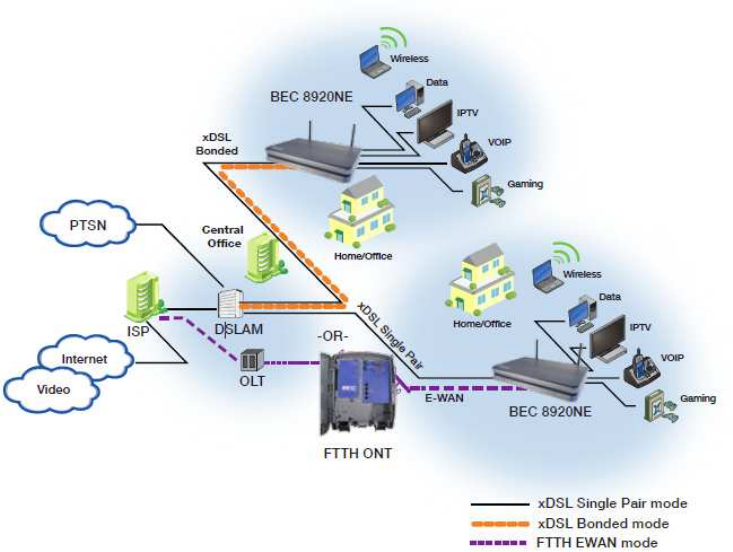
6
Hardware Specifications
Physical interface
• DSL: Single xDSL RJ-11 Interface
• EWAN: Giga Ethernet WAN port can be connected to ADSL/Cable/VDSL/Fiber modem device
• Ethernet MDI/MDIX Switch: 3-port 10/100Mbps and 1-10/100/1000Mbps port (GigaConnect ® )
• Factory default reset button
• WPS push button
• Power jack
• Power switch
• WLAN: 2 antennas
Physical Specifications
• Dimensions: 9.04" x 6.10" x 1.46" (229.5mm x 155mm x 37mm)
Applications Diagram
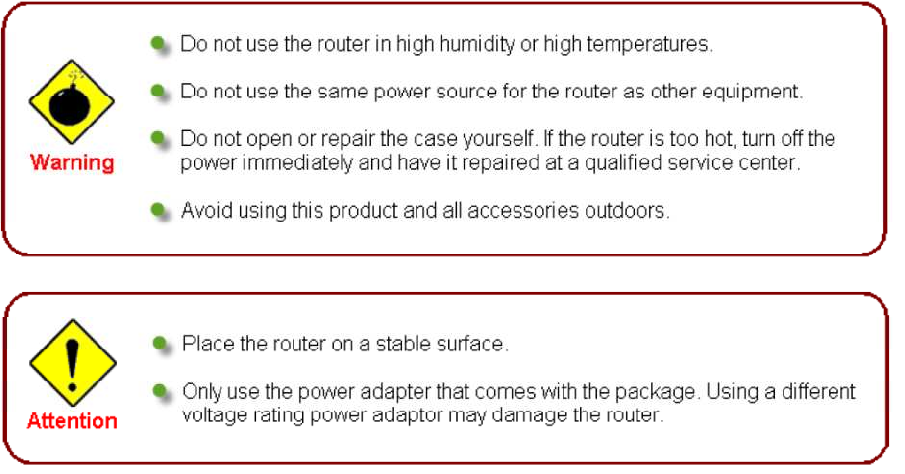
7
Chapter 2: Product Overview
Important note for using this router
Package Contents
BEC 8920NE The Ultimate Residential Gateway
RJ-45 Ethernet Cable
Y-Cable for VDSL bonded operation
Two wireless detachable antennas
Power adaptor
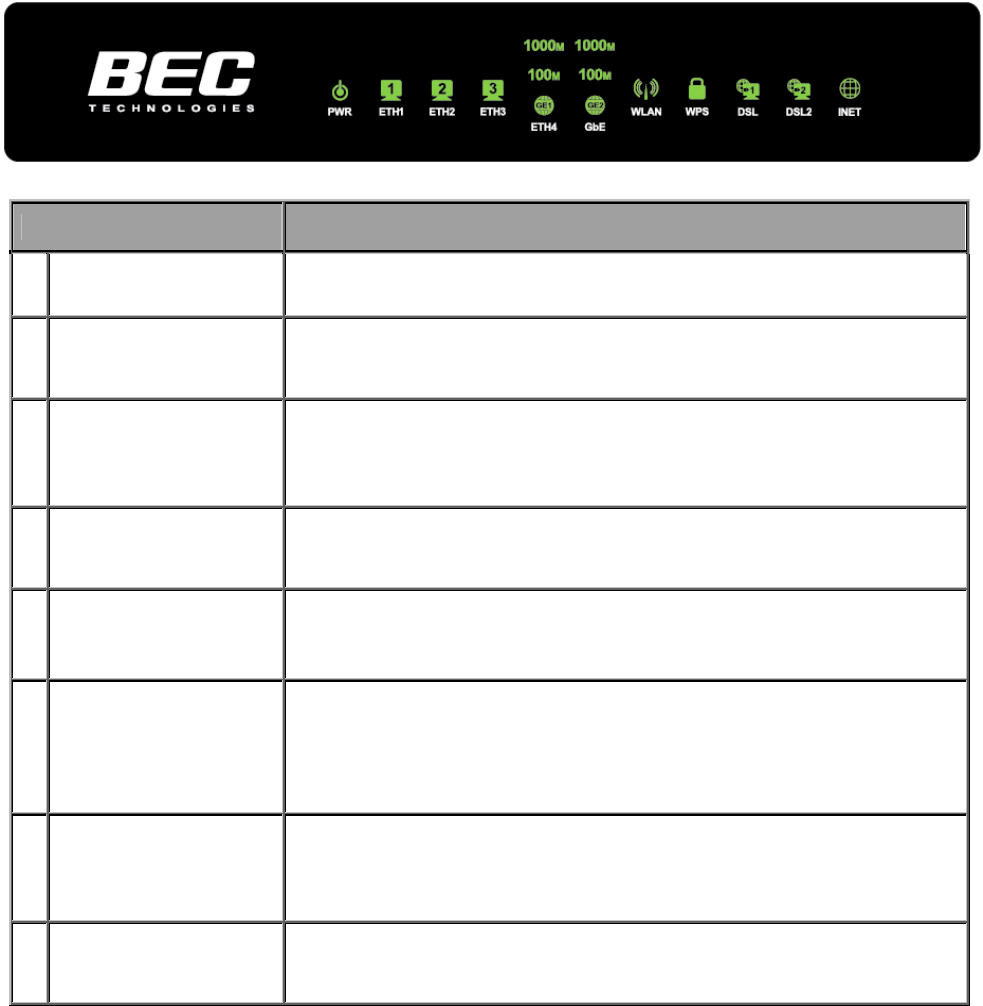
Device Description
The Front LEDs
LED Function
1
Power (PWR) Lit green: when the device is ready.
No light: when no power is connected.
2
Ethernet (ETH) 1 - 3
Lit green: when LAN port is connected to an Ethernet device.
Flashing green: when data is being Transmitted / Received.
No light: when no LAN port is not being connected.
3
Gigabit Ethernet
(ETH) 4
This is a Gigabit LAN Ethernet port.
Lit green: when LAN port is connected to an Ethernet device.
Flashing green: when data is being Transmitted / Received.
No light: when no LAN port is not being connected.
4
GbEthernet (GbE) WAN port for broadband connectivity
Lit green: when connected to a Cable modem, xDSL modem, Fiber
(PON) modem's Ethernet port.
5
Wireless (WLAN) Lit green: when the wireless connection is enabled.
Flashing green: when the device is sending/receiving data.
No light: when wireless function is off
6
WPS
Lit green: when wireless device(s) has connected successfully
connected to the wireless network via WPS mode.
Flashing green: when WPS is enabled and trying to establish a
WPS connetion.
No light: when WPS function is off
7
DSL / DSL2
Lit green: DSL is in sych with DSLAM and connection is up.
Quick Flashing green: DSL trys to establish handshke with the
DSLAM.
Slow Flashing green: No DSL link
8
INET Lit green: when Internet is being connected; IP recieved.
Flashing green: when the device is sending/recieving data traffic.
No light: Device is either off or DSL failed to connect.
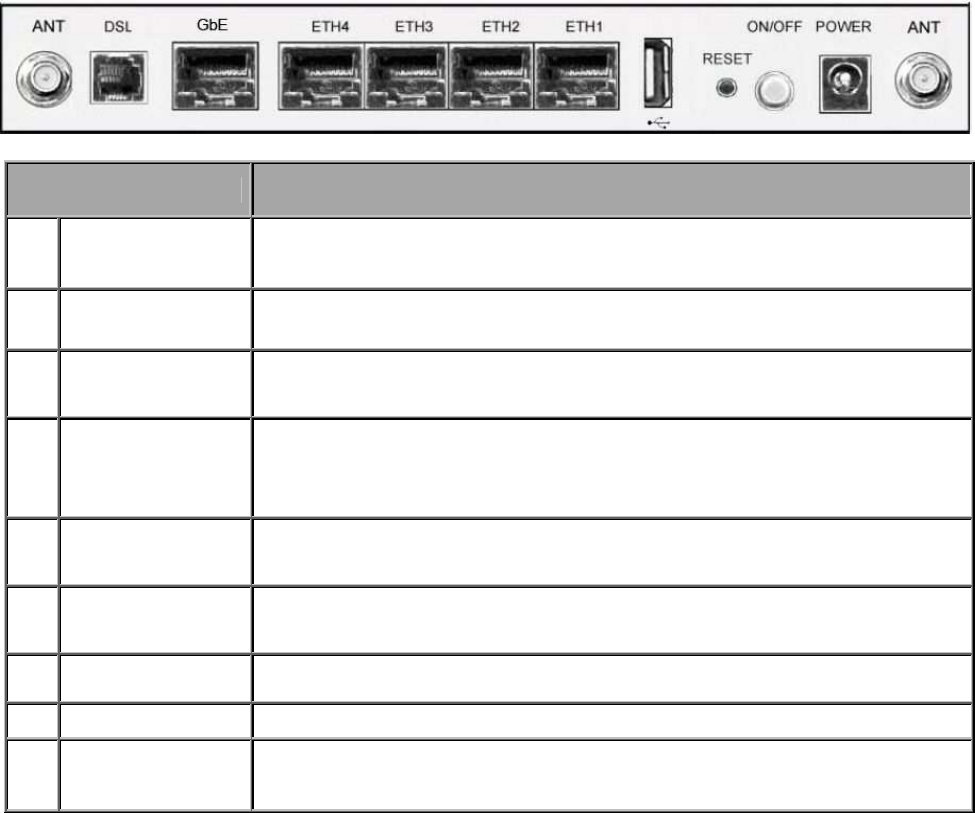
9
The Rear Ports
Port Function
1
Wireless
detachable
antenna
(ANT)
Connect a wireless detachable antenna to this port.
2 DSL Connect the device to an ADSL/VDSL telephone jack or splitter using a
RJ-11 telephone cable
3 WAN Connect to a Cable modem, xDSL modem, Fiber (PON) modem.
4 Ethernet (1~4) Connect your computer or an Ethernet device to a LAN port, using the
included Ethernet cable.
5 USB
*
future release
Both USB1 and USB2 can be connected to a USB device, such as,
HDD.
*
future release
6 Reset Button Press it to reset the device or restore to factory default settings.
7 Power Switch Power ON/OFF switch
8 Power Jack Connect the supplied power adapter to this jack.
9
Wireless
detachable
antenna
(AN
T)
Connect the 3G / 4G detachable antenna to this port.
Cabling
The most common problem associated with Ethernet is bad cabling. Make sure that all connected
devices are turned on. In the front of the product is a bank of LEDs. Verify that the LAN Link and
WAN Link LEDS are lit. If they are not, verify that you are using the proper cables.

10
Chapter 3: Basic Installation
You can configure the BEC 8920NE The Ultimate Residential Gateway through the convenient
and user-friendly interface of a web browser. Most popular operating systems such as Linux and
Windows 98 / NT /2000 / XP / ME / 7 / Vista include a web browser as a standard application.
PCs must have a properly installed Ethernet interface which connects to the router directly or
through an external repeater hub. In addition, PCs must have TCP/IP installed and configured to
obtain an IP address through a DHCP server or a fixed IP address that must be in the same subnet
as the router. The default IP address of the router is 192.168.1.254 and the subnet mask is
255.255.255.0 (i.e. any attached PC must be in the same subnet, and have an IP address in the
range between 192.168.1.1 and 192.168.1.253). The easiest way is to configure the PC is to obtain
an IP address automatically from the router using DHCP. If you encounter any problems accessing
the router’s web interface you are advised to uninstall any kind of software firewall on your PCs, as
they can cause problems when trying to access the 192.168.1.254 IP address of the router.
Please follow the steps below for installation on your PC’s network environment. First of all, check
your PC’s network components. The TCP/IP protocol stack and Ethernet network adapter must be
installed. If not, please refer to your Windows-related or other operating system manuals.
Any TCP/IP capable workstation can be used to communicate with or
through the BEC 8920NE The Ultimate Residential Gateway. To
configure other types of workstations, please consult the
manufacturer’s documentation.
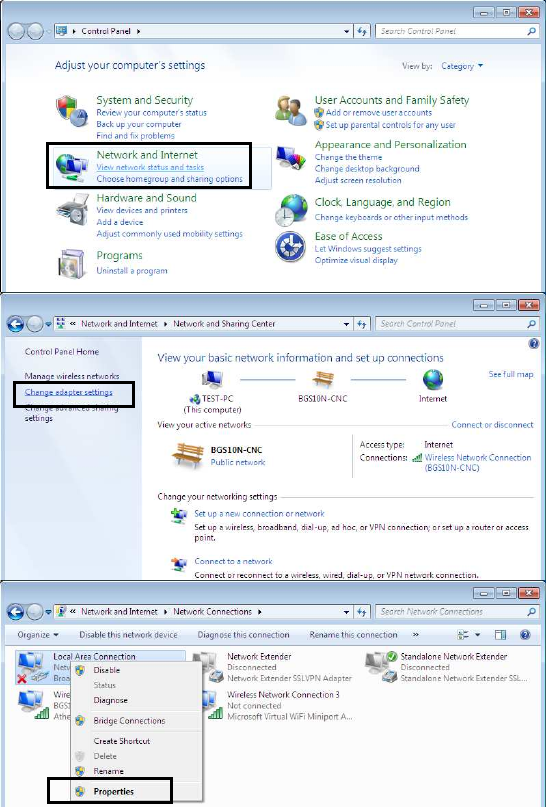
Network Configuration
Configuring a PC in Windows 7
1. Go to Start. Click on
Control Panel.
2. Then click on Network and
Internet.
3. When the Network and
Sharing Center window
pops up, select and click on
Change adapter settings
on the left window panel.
4. Select the Local Area
Connection, and right click
the icon to select
Properties.
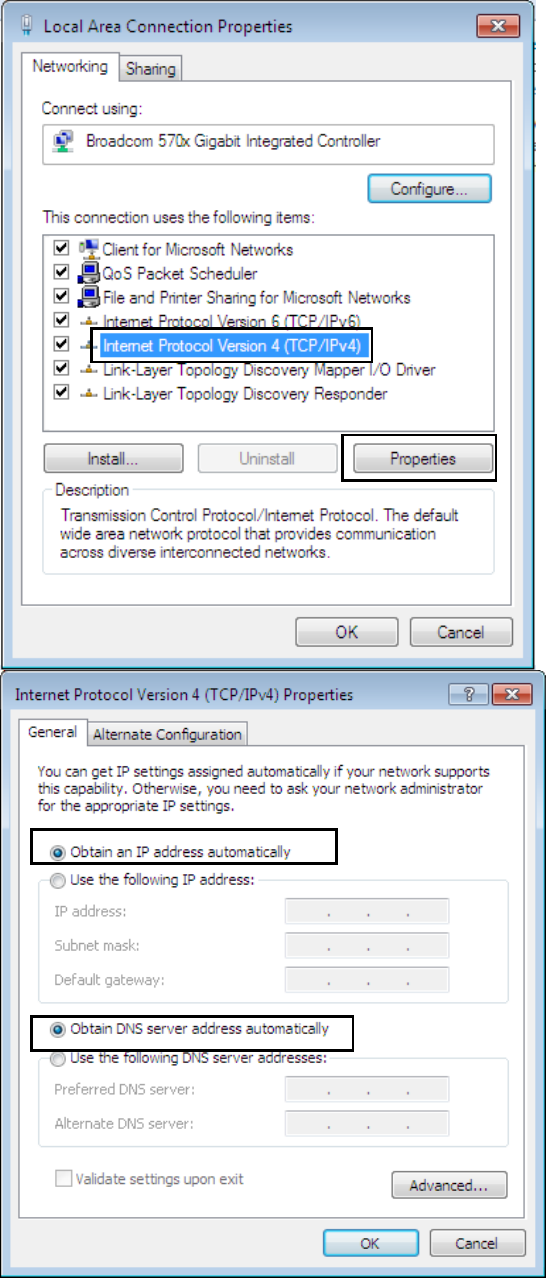
5. Select Internet Protocol
Version 4 (TCP/IPv4) then
click Properties.
6. In the TCP/IPv4 properties
window, select the Obtain
an IP address
automatically and Obtain
DNS Server address
automatically radio
buttons. Then click OK to
exit the setting.
7. Click OK again in the Local
Area Connection
Properties window to apply
the new configuration.
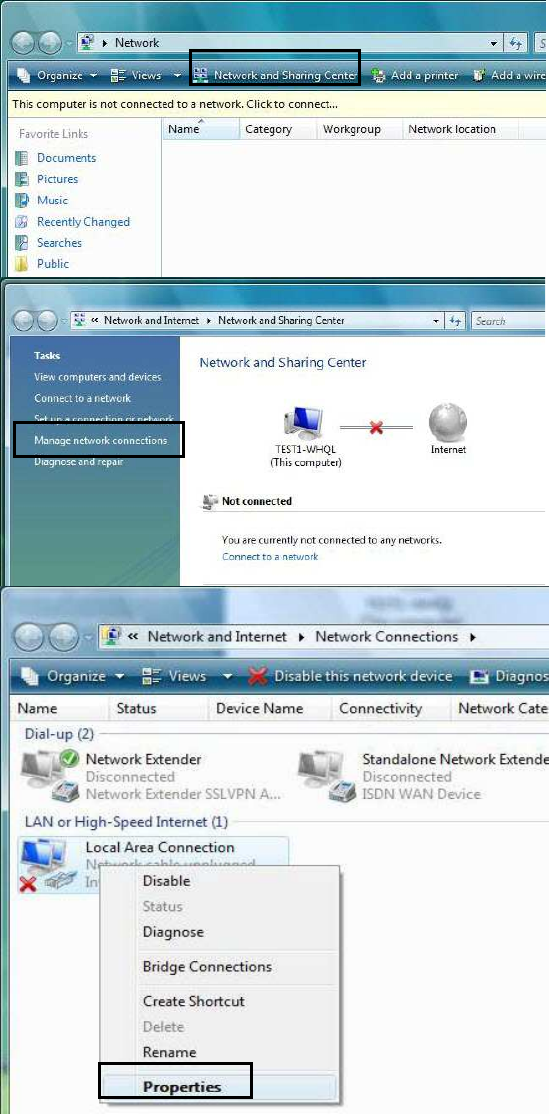
Configuring a PC in Windows Vista
1.
Go to
Start
. Click on
Network.
2. Then click on Network and
Sharing Center at the top
bar.
3.
When the
Network and
Sharing Center window
pops up, select and click on
Manage network
connections on the left
window pane.
4.
Select the
Local Area
Connection, and right click
the icon to select
Properties.
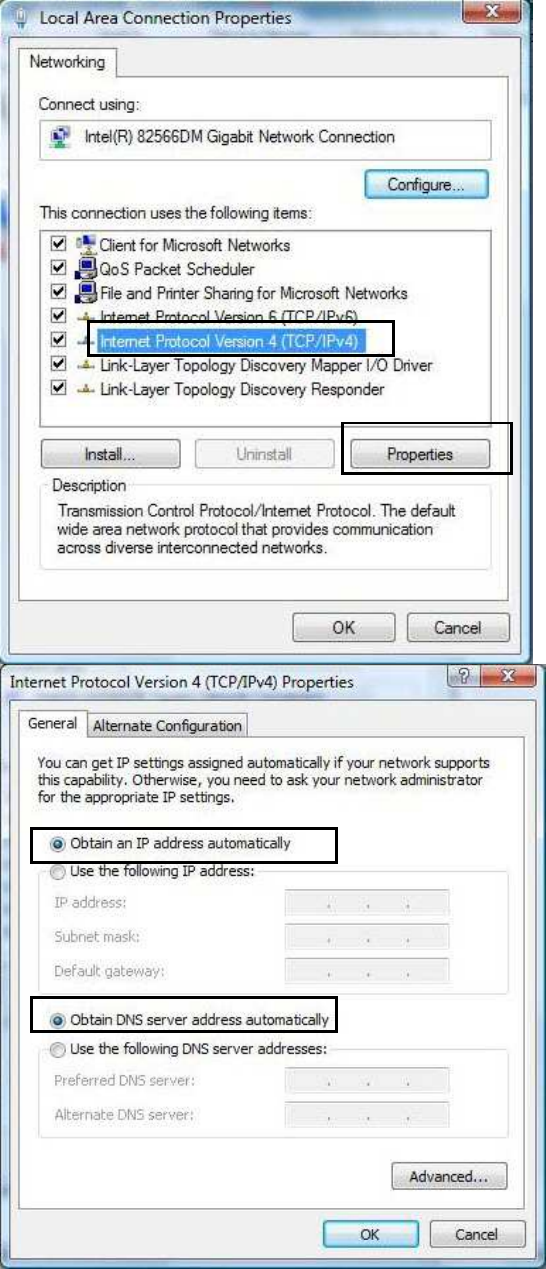
5. Select Internet Protocol
Version 4 (TCP/IPv4) then
click Properties.
6.
In the
TCP/IPv4 properties
window, select the Obtain an
IP address automatically
and Obtain DNS Server
address automatically
radio buttons. Then click OK
to exit the setting.
7. Click OK again in the Local
Area Connection
Properties window to apply
the new configuration.
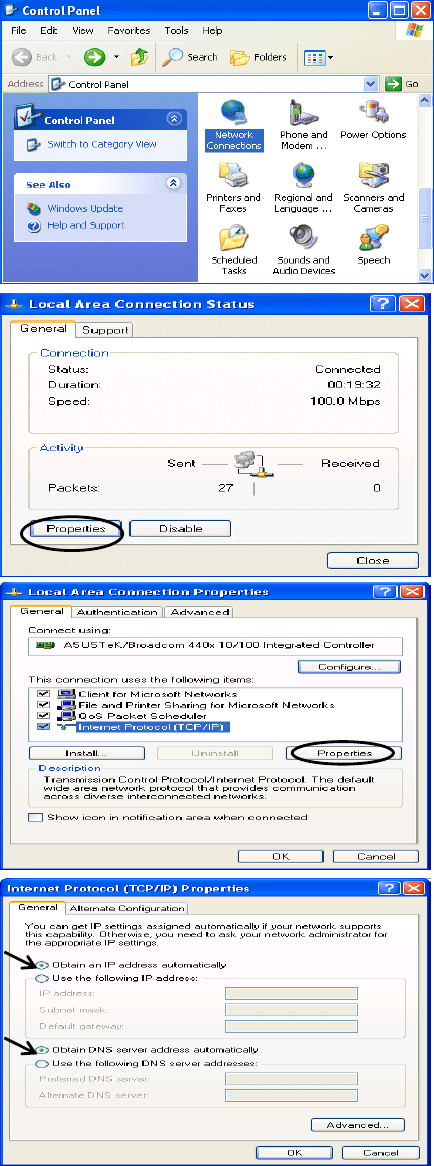
Configuring a PC in Windows XP
1. Go to Start. Click on Control Panel.
2. Then click on Network and Internet.
3. In the Local Area Connection Status
window, click Properties.
4. Select Internet Protocol (TCP/IP) and
click Properties.
5. Select the Obtain an IP address
automatically and the Obtain DNS
server address automatically radio
buttons.
6. Click OK to finish the configuration.
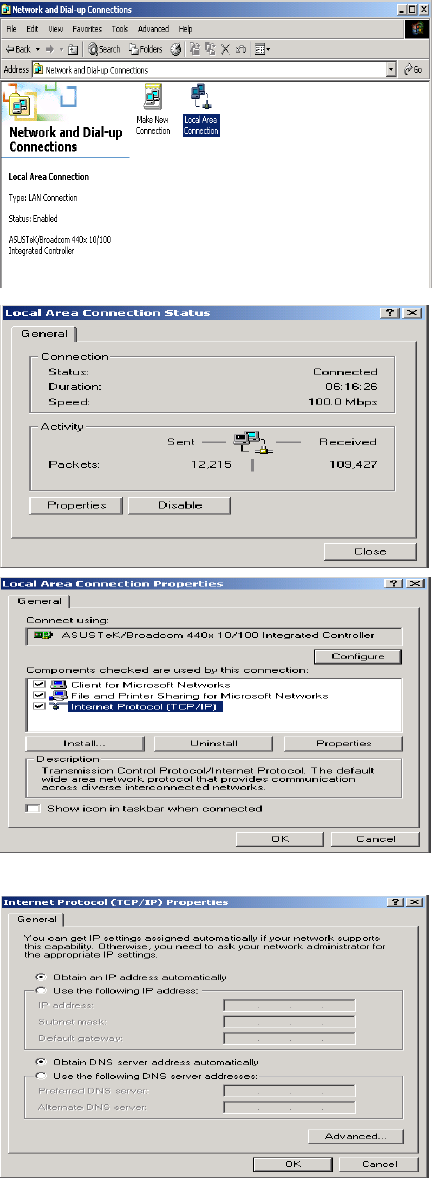
16
Configuring a PC in Windows 2000
1. Go to Start / Settings / Control Panel.
In the Control Panel, double-click on
Network and Dial-up Connections.
2. Double-click Local Area Connection.
3. In the Local Area Connection Status
window click Properties.
4. Select Internet Protocol (TCP/IP) and
click Properties.
5. Select the Obtain an IP address
automatically and the Obtain DNS
server address automatically radio
buttons.
6. Click OK to finish the configuration.
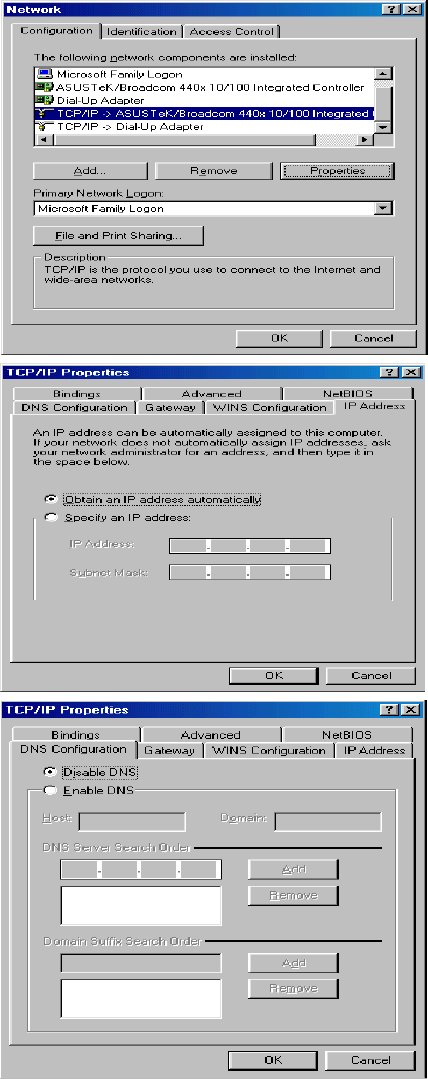
17
Configuring PC in Windows 98/Me
1. Go to Start / Settings / Control Panel.
In the Control Panel, double-click on
Network and choose the
Configuration tab.
2. Select TCP/IP ->NE2000 Compatible,
or the name of your Network Interface
Card (NIC) in your PC.
3. Select the Obtain an IP address
automatically radio button.
4. Then select the DNS Configuration
tab.
5. Select the Disable DNS radio button
and click OK to finish the configuration.
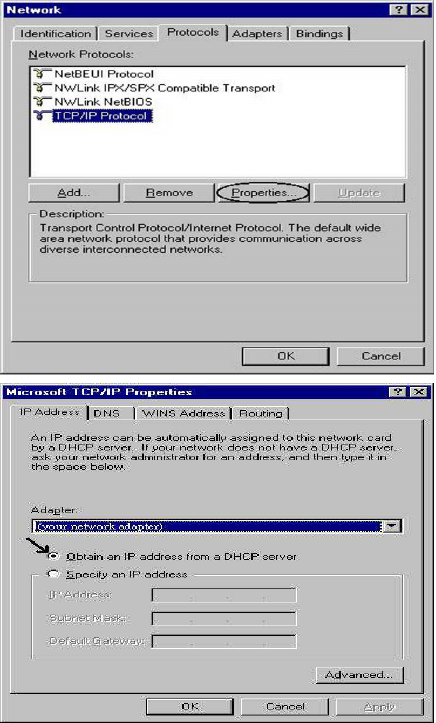
18
Configuring PC in Windows NT4.0
1. Go to Start / Settings / Control Panel.
In the Control Panel, double-click on
Network and choose the Protocols tab.
2. Select TCP/IP Protocol and click
Properties.
3. Select the Obtain an IP address from a
DHCP server radio button and click OK.
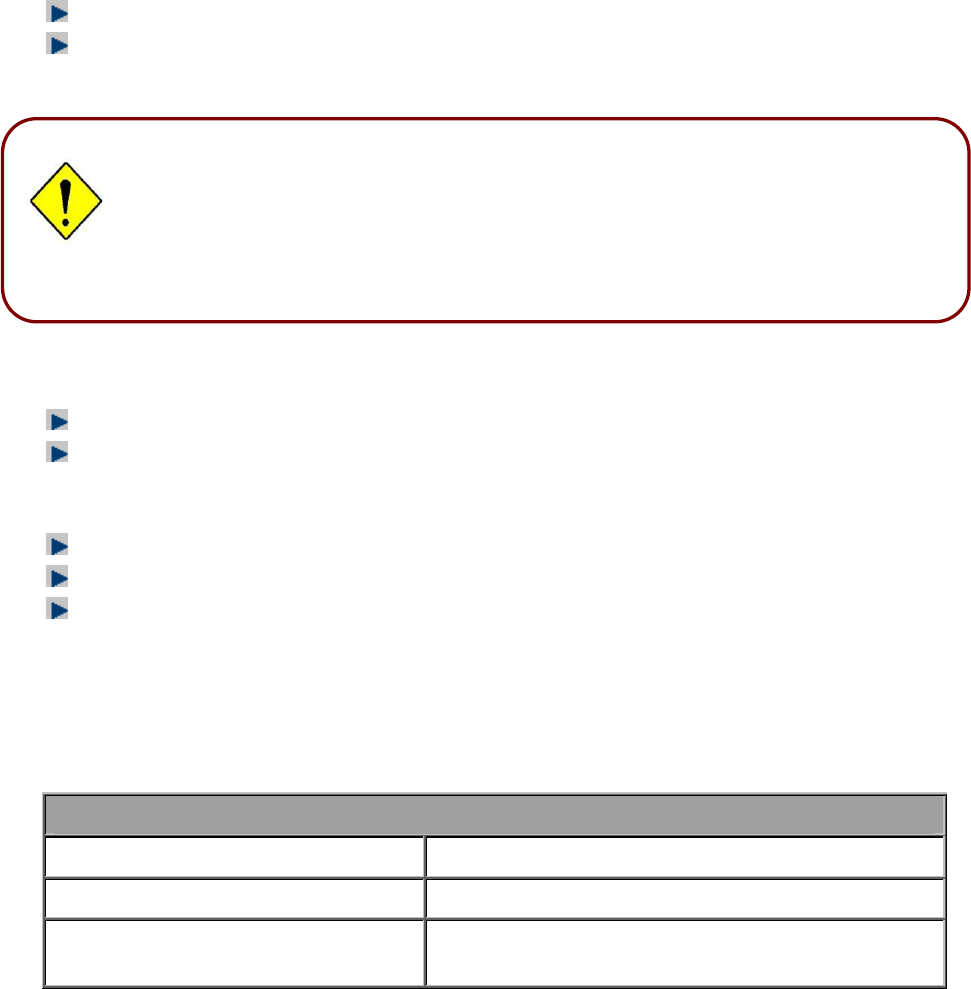
Factory Default Settings
Before configuring the router, you need to know the following default settings.
Web Interface: (Username and Password)
Username: admin
Password: admin
The default username and password are “admin” and “admin” respectively.
Device LAN IP settings
IP Address: 192.168.1.254
Subnet Mask: 255.255.255.0
DHCP server
DHCP server is enabled.
Start IP Address: 192.168.1.100
IP pool counts: 100
LAN Port Addresses
The parameters of LAN and WAN ports are preset at the factory. The default values are shown
below.
LAN Port
IP address 192.168.1.254
Subnet Mask 255.255.255.0
IP addresses for distribution to
PCs 100 IP addresses continuing from 192.168.1.100
through 192.168.1.199
Attention
If you ever forget the username/password to login to the router, you may
press the RESET button up to 6 seconds then release it to restore the
factory default settings.
Caution: After pressing the RESET button for more than 6 seconds then
release it, to be sure you power cycle the device again.
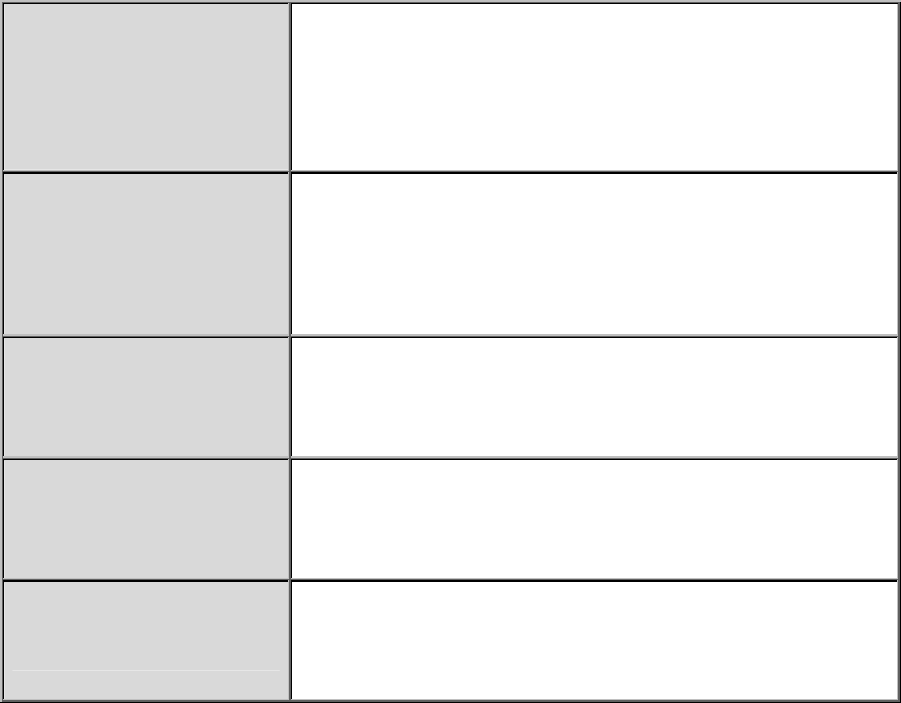
20
Information from your ISP
Before configuring this device, you have to check with your ISP (Internet Service Provider) what kind
of services are provided, such as PPPoE, Obtain an IP Address Automatically, Fixed IP address.
Gather the information as illustrated in the following table and keep it for reference.
PPPoE(RFC2516)
VPI/VCI, VC / LLC-based multiplexing, Username,
Password, Service Name, and Domain Name System
(DNS) IP address (it can be automatically assigned by your
ISP when you connect or be set manually)
PPPoA(RFC2364)
VPI/VCI, VC / LLC-based multiplexing, Username,
Password and Domain Name System (DNS) IP address (it
can be automatically assigned by your ISP when you
connect or be set manually)
Obtain an IP Address
Automatically
DHCP Client (it can be automatically assigned by your ISP
when you connect or be set manually).
Fixed IP Address IP address, Subnet mask, Gateway address, and Domain
Name System (DNS) IP address (it is fixed IP address).
Bridge VPI/VCI, VC / LLC-based multiplexing to use Bridged Mode
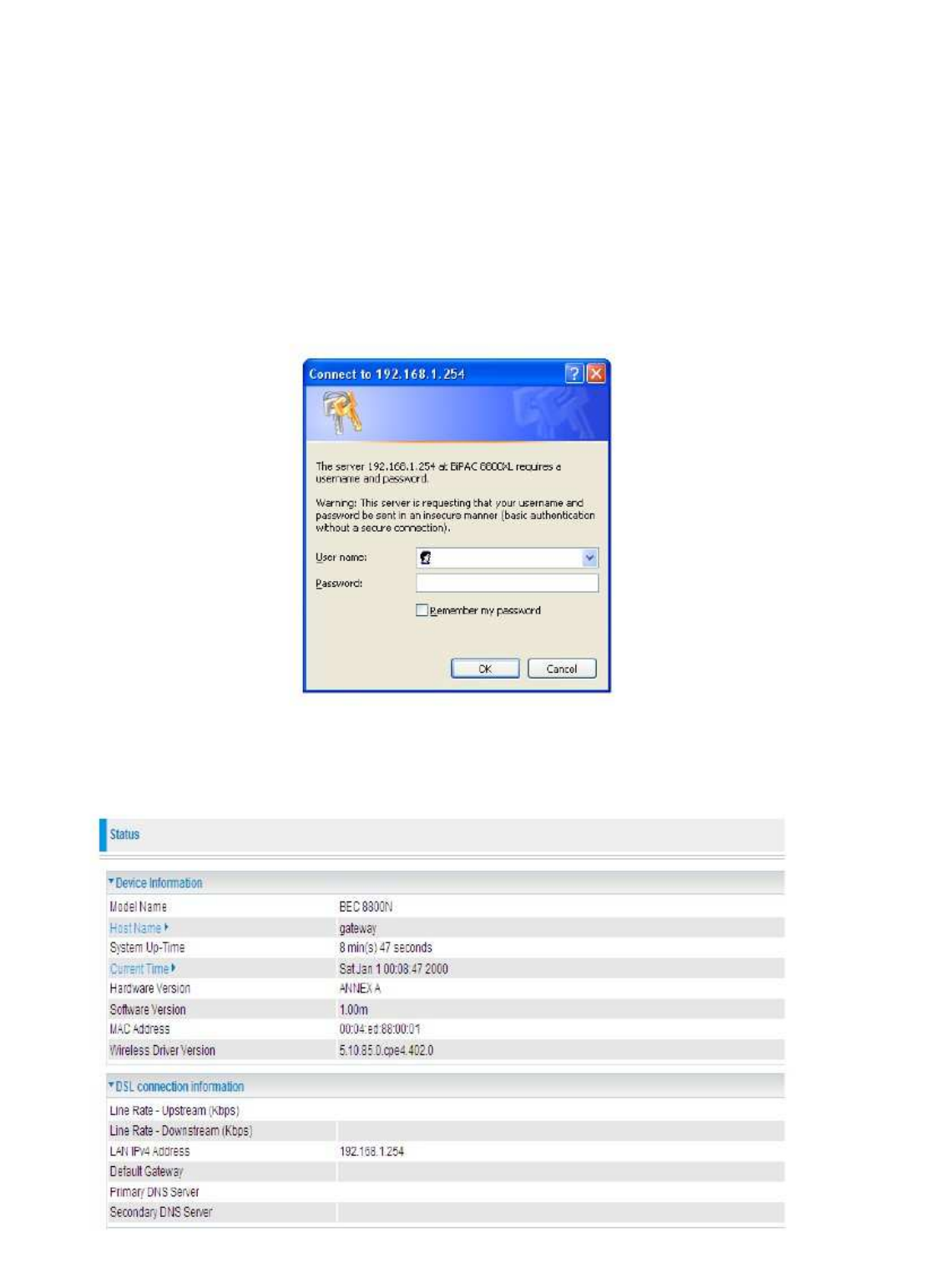
21
Configuring with your Web Browser
Open your web browser, enter the IP address of your router, which by default is 192.168.1.254, and
click “Go”, a user name and password window prompt appears. Enter the user name and password
that your administrator has set for you then click OK. When you are authorised, you will access to
the router.
The default username and password are “admin” and “admin” respectively for the Administrator
account type.
Congratulations! You have successfully logged on to your BEC 8920NE The Ultimate Residential
Gateway!

22
Chapter 4: Basic Configuration
Once you have logged on to your router via your web browser, you can begin to set it up according to
your requirements. On the configuration homepage, the left navigation pane links you directly to the
setup pages, which includes:
Status
- WAN Info
- Statistics
- Route Table
- ARP Table
- DHCP Table
- System Log
Configuration
- LAN
- WAN
- System
- Firewall
- QoS
- Virtual Server
- Advanced
Diagnoistic
- Diagnostics
- Fault Management
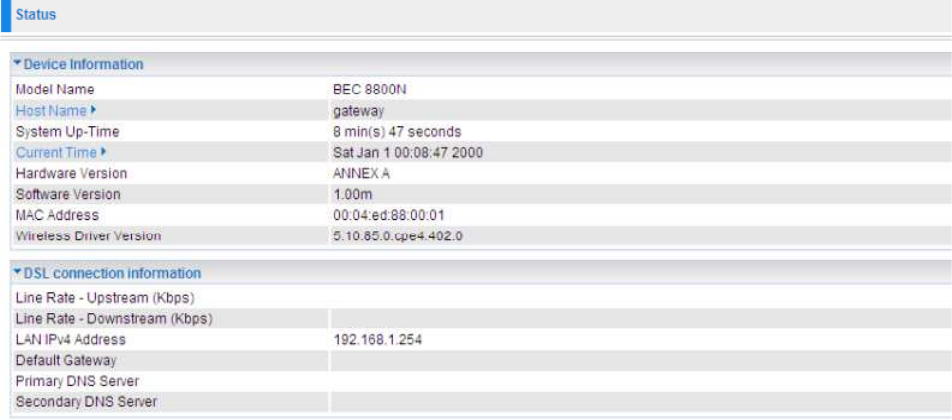
23
Status
Device Information
Model Name: Displays the model name.
Host Name: Provide a name for the router for identification purposes. Host Name lets you change the
router name.
System Up-Time: Records system up-time.
Current time: Set the current time. See the Time Zone section for more information.
Hardware Version: Device version.
Software Version: Firmware version.
MAC Address: The LAN MAC address.
DSL connection information
DSL connection information: User can look up to see all the informaion for DSL connection:
Upstream/Downstream Line Rate (Kbps), LAN IPv4 Address, Default Gateway, and Primary/Secondary
DNS Server.
24
WAN Info
The WAN Info screen displays the configured PVC(s) and the status.
Interface: Shows connection interfaces.
Description: Shows the user defined name of WAN service.
Type: Shows the connection type, such as PPPoE, IPoE and so on.
VlanMuxld: Shows the status of the VLAN Muxld.
Igmp: Shows the status of the IGMP function.
NAT: Shows the status of the NAT.
Firewall: Shows the status of the firewall.
Status: Shows the connection state of the WAN connection.
IPv4 Address: Shows IP address for WAN interface.
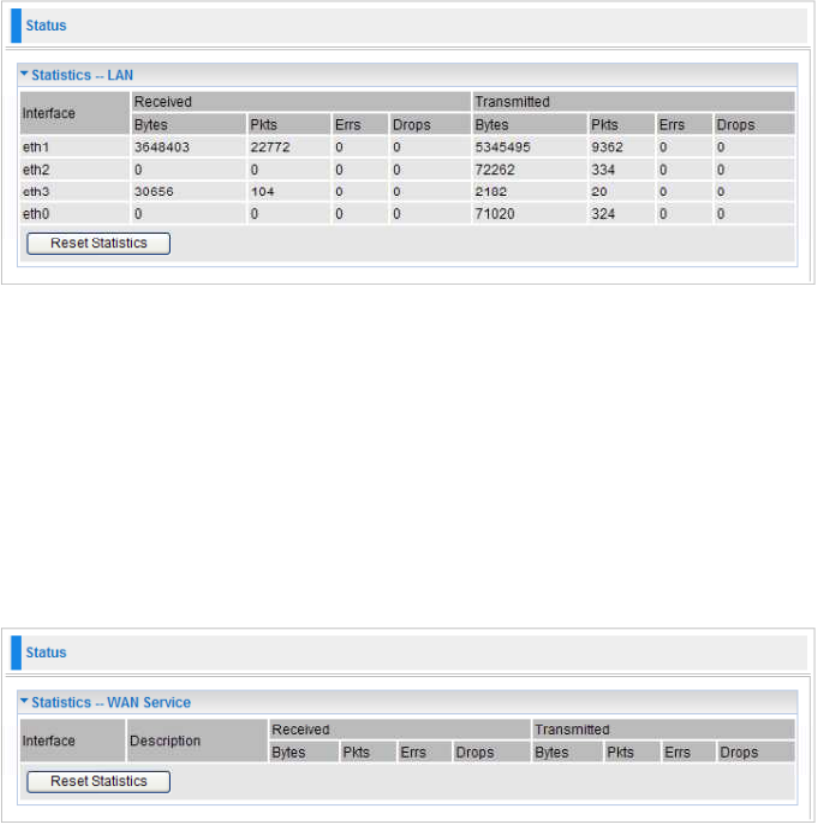
25
Statistics
These are the items within the Statistics section: LAN, WAN Service, xTM and xDSL.
LAN
This screen shows interface statistics for LAN of Ethernet interfaces.
Interface: Lists connection interfaces.
Received/Transmitted Bytes: Rx/TX (receive/transmit) packet in Byte.
Received/Transmitted Pkts: Rx/TX (receive/transmit) packets.
Received/Transmitted Errs: Rx/TX (receive/transmit) packets that are errors.
Received/Transmitted Drops: Rx/TX (receive/transmit) packets that are dropped.
Reset statistics: Click to update the statistics.
WAN Service
This screen shows the current statistics for WAN.
Interface: Shows connection interfaces.
Description: Shows the user defined name of WAN service.
Received/Transmitted Bytes: Rx/TX (receive/transmit) packet in Byte.
Received/Transmitted Pkts: Rx/TX (receive/transmit) packets.
Received/Transmitted Errs: Rx/TX (receive/transmit) packets that are errors.
Received/Transmitted Drops: Rx/TX (receive/transmit) packets that are dropped.
Reset statistics: Click to update the statistics.

26
xTM
The Statistics-xTM screen displays all the xTM statistics.
Port Number: Shows number of the port for xTM.
In Octets: Number of received octets over the interface.
Out Octets: Number of transmitted octets over the interface.
In Packets: Number of received packets over the interface.
Out Packets: Number of transmitted packets over the interface.
In OAM Cells: Number of OAM cells received.
Out OAM Cells: Number of OAM cells transmitted.
In ASM Cells: Number of ASM cells received.
Out ASM Cells: Number of ASM cells transmitted.
In Packet Errors: Number of received packets with errors.
In Cell Errors: Number of received cells with errors.
Reset: Click to reset the statistics.
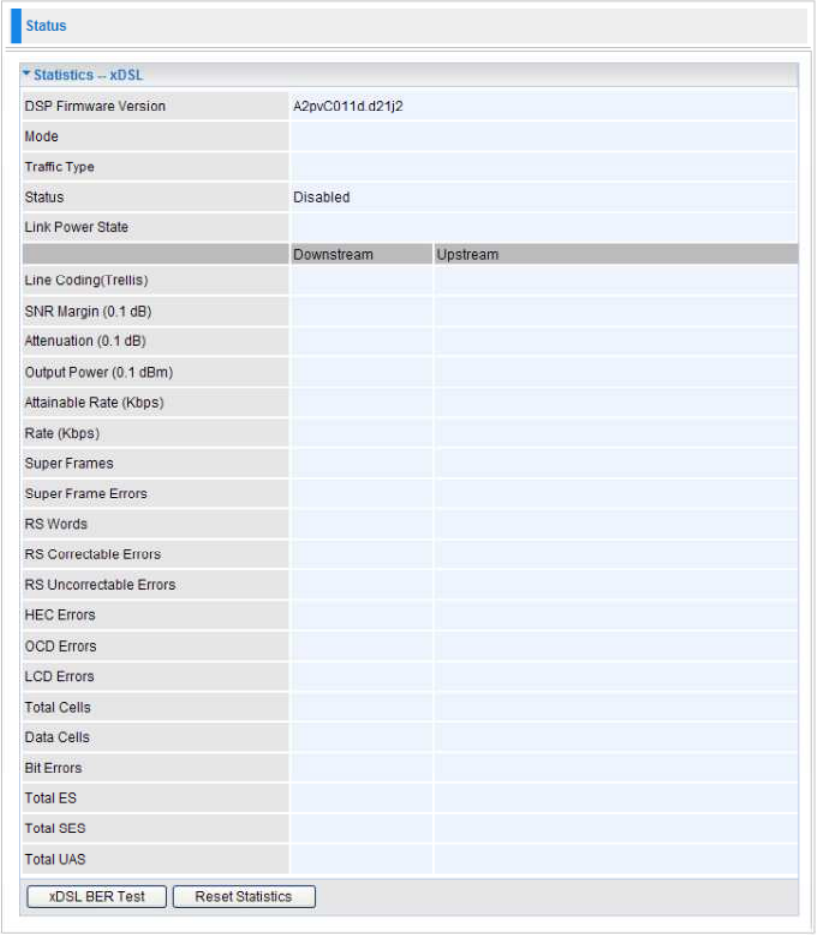
27
xDSL
The Statistics-xDSL screen displays all the xDSL network statistics.
DSP Firmware Version: DSP code version.
Mode: Modulation protocol, including G.dmt, G.lite, T1.413, ADSL2, ADSL2+ and VDSL2.
Traffic Type: Channel type, including ATM or PTM.
Status: Shows the status of the DSL link.
Link Power State: Shows link output power state.
Upstream: Upstream rate.
Downstream: Downstream rate.
Line Coding(Trellis): Trellis On/Off.
SNR Margin (0.1 dB): This shows the Signal to Noise Ratio (SNR) margin.
Attenuation (0.1 dB): This is estimate of average loop attenuation of signal.

28
Output Power (0.1 dBm): Total upstream output power.
Attainable Rate (Kbps): The sync rate you would obtain.
Rate (Kbps): Current sync rate.
Super Frames: Total number of super frames.
Super Frame Errors: Number of super frames received with errors.
RS Words: Total number of Reed-Solomon code errors.
RS Correctable Errors: Total number of RS with correctable errors.
RS Uncorrectable Errors: Total number of RS words with uncorrectable errors.
HEC Errors: Total number of Header Error Checksum errors.
OCD Errors: Total number of out-of-cell Delineation errors.
LCD Errors: Total number of Loss of Cell Delineation.
Total Cells: Total number of cells.
Data Cells: Total number of data cells.
Bit Errors: Total number of bit errors.
Total ES: Total Number of Errored Seconds.
Total SES: Total Number of Severely Errored Seconds.
Total UAS: Total Number of Unavailable Seconds.
xDSL BER Test: Click this button to start a bit Error Rate Test.
Reset Statistics: Click this button to reset the statistics.
Route Table
The Rout Table provides users with a database in the router that contains current network topology such
as current paths for transmitted packets. Both static and dynamic routes are displayed.
Destination: Displays the IP address of the destination network.
Gateway: Displays the IP address of the gateway that this route uses.
Subnet Mask: Displays the destination subnet mask address.
Metric: Displays the number of hops counted as the Metric of the route.
Service: Displays the current service that this route uses.
Interface: Displays the existing interface that this route uses.

29
ARP Table
This table stores mapping information that the device uses to find the Layer 2 Media Access Control
(MAC) address that corresponds to the Layer 3 IP address of the device via the Address Resolution
Protocol (ARP) feature.
IP Address: Shows the IP Address of the device that the MAC address maps to.
MAC Address: Shows the MAC address that is corresponded to the IP address of the device it is
mapped to.
Interface: The interface name (on the router) that this IP address connects to.
DHCP Table
This Table lists the DHCP lease information for all IP addresses assigned by the DHCP server in the
device.
Hostname: The Hostname of internal dhcp client.
MAC Address: The MAC Address of internal dhcp client host.
IP Address: This is the IP address that is assigned to the host with this MAC address.
Expires In: Shows the information provided during registration.
System Log
Display system logs accumulated up to the present time. You can trace its historical information with this
function.
Refresh: Click to update the system log.
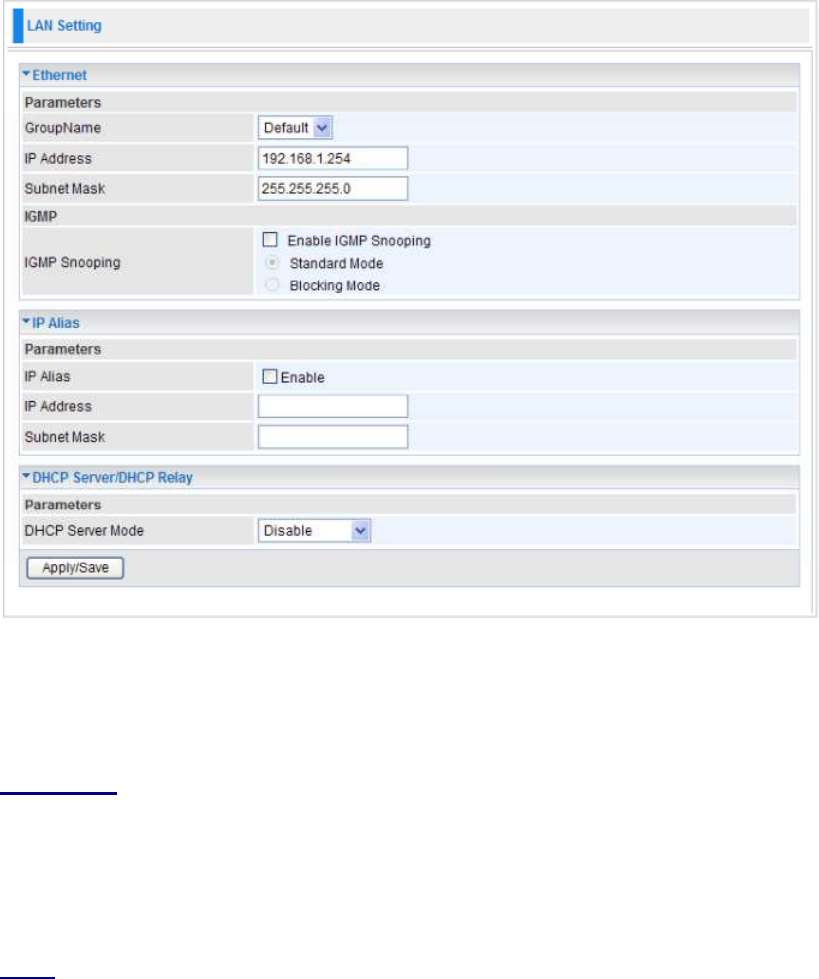
30
Configuration
When you click this item, the column will expand to display the sub-items that will allow you to further
configure your BEC 8920NE router.
LAN, WAN, System, Firewall, QoS, Virtual Server and Advanced.
The function of each configuration sub-item is described in the following sections.
LAN - Local Area Network
A Local Area Network (LAN) is a shared communication system network where many computers are
connected. This type of network is area defined and is usually limited to a confined region within a
building or just within the same storey of a building.
Ethernet
The router supports more than one Ethernet IP addresses in the LAN, and with distinct LAN subnets
through which you can access the Internet at the same time. Users usually only have one subnet in their
LAN. The default IP address for the router is 192.168.1.254.
Parameters
GroupName: Select the groupname from the listbox. You can add new groups on Interface Grouping
screen (Configuration>Advanced>Interface Grouping, please refer to Interface Grouping section).
IP Address: Enter the default IP on this router.
Subnet Mask: Enter the default subnet mask on this router.
IGMP
IGMP Snooping: Allows a layer 2 switch to manage the transmission of any incoming IGMP multicast
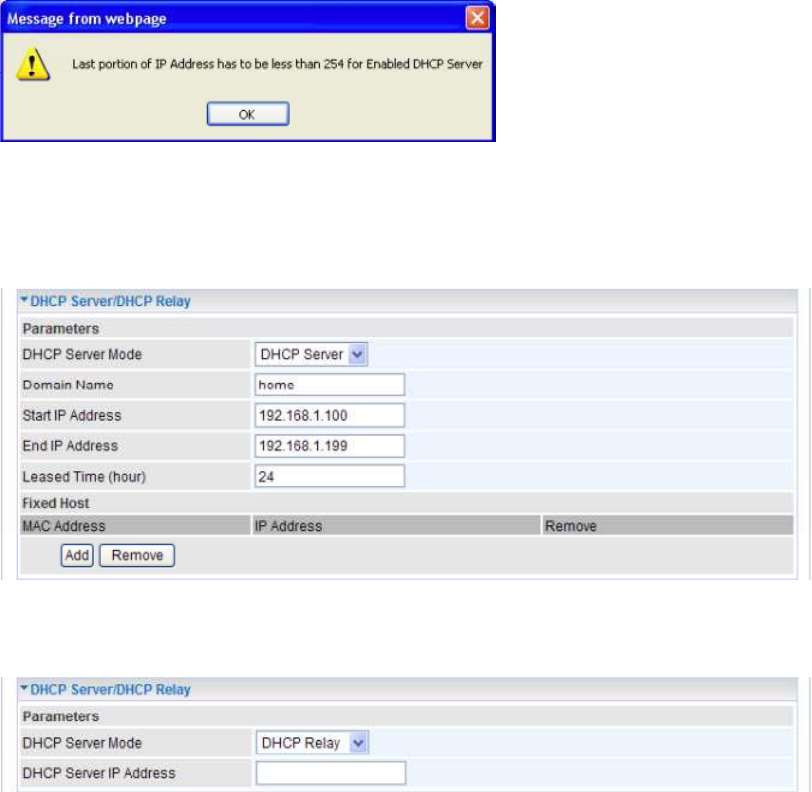
31
packet groups between the host and the router. Default is set to Disable. Check Enable IGMP Snooping
check box to activate this function and choose Standard Mode or Blocking Mode.
IP Alias
This function allows the addition an IP alias to the network interface. This further allows user flexibly to
assign a specific function to use this IP.
IP Alias: Check Enable check box to activate this function.
IP Address: Enter the IP address to be added to the network.
Subnet Mask: Specify a subnet mask for the IP to be added.
DHCP Server/DHCP Relay
DHCP allows networked devices to obtain information on the parameter of IP, Netmask, Gateway as well
as DNS through the Ethernet Address of the device.
To configure the router’s DHCP Server, select DHCP Server from the DHCP Server Mode drop-down
menu. A message window will pop up to remind you as below. Click OK to continue.
You can then configure parameters of the DHCP Server including the domain name, IP pool (starting IP
address and ending IP address to be allocated to PCs on your network) and lease time for each
assigned IP address (the period of time the IP address assigned will be valid). These details are sent to
the DHCP client (i.e. your PC) when it requests an IP address from the DHCP server. Click Add to save
this entry or Remove to delete an existing entry.
If you select DHCP Relay from the DHCP Server Mode drop-down menu, you must enter the IP address
of the DHCP server that assigns an IP address to the DHCP client in the LAN. Use this function only if
advised to do so by your network administrator or ISP.
Click Apply/Save to confirm the changes and enable the above functions.
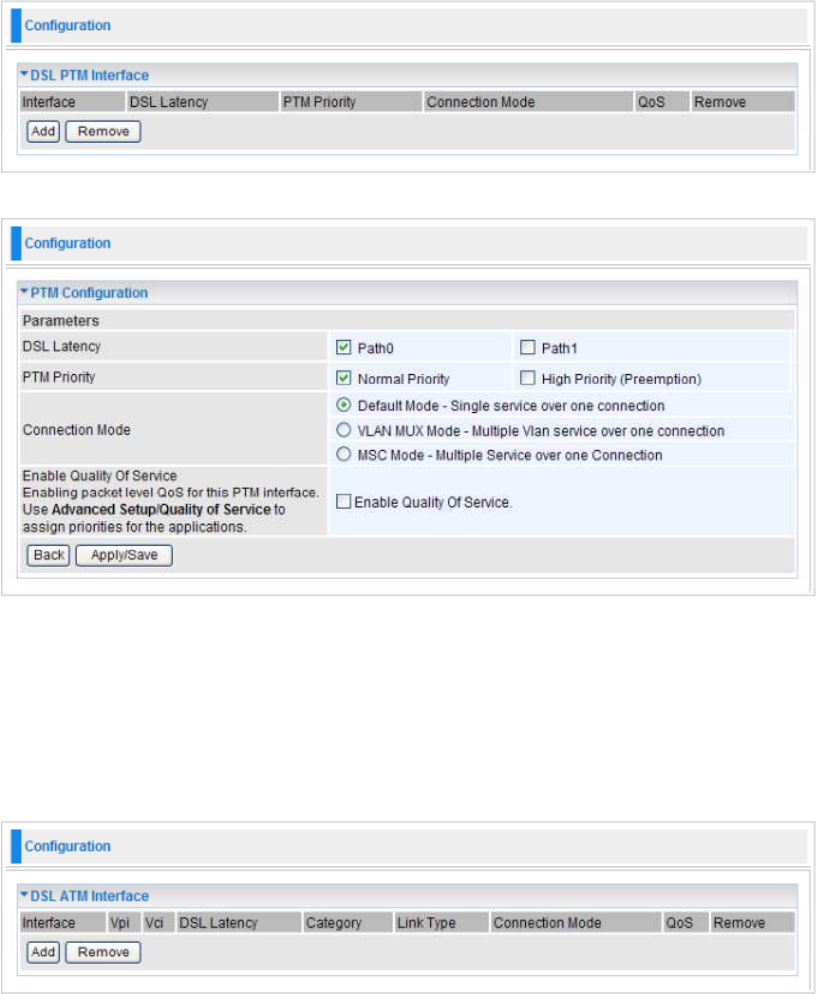
32
WAN - Wide Area Network
A WAN (Wide Area Network) is a computer network that covers a broad geographical area (eg. Internet)
that is used to connect LAN and other types of network systems. There are the items within the WAN
section: Layer2 Interface, WAN Service and DSL.
Layer2 Interface
PTM Interface (VDSL)
Click Add to go to PTM Configuration screen.
On this screen, you can configurate a PTM connection. Check DSL Latency, set PTM Priority, and
choose the appropriate Connection Mode. If you want to activate packet level QoS for this PTM
interface, check Enable Quality Of Service check box (To assign priorities for the applications, please
use Advanced Setup>Quality of Service.).
Click Apply/Save to save the changes or Back to return to DSL PTM Interface table.
ATM Interface (ADSL)
Click Add to go to ATM PVC Configuration screen.
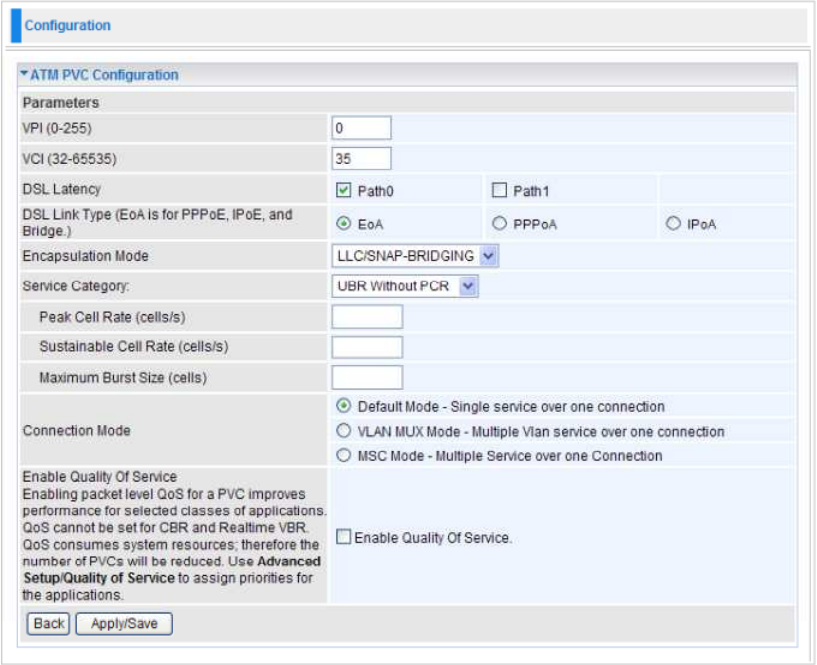
33
VPI (0~255) / VCI (32~65535): Enter the VPI/VCI values provided by your ISP.
DSL Latency: Check Path0 or Path1 for DSL latency.
DSL Link Type: Select EoA (which is for PPPoE, IPoE and Bridge), PPPoA, or IPoA. Select the one
provided by your ISP.
Encapsulation Mode: Select the encapsulation mode. Different options will be provided for different
DSL link types. Select the one provided by your ISP.
Service Category: Describes the ATM Quality Of Service (QoS) being used on the VC.
Peak Cell Rate (cells/s): Specifies the upstream peak cell rate in cells per second.
Sustainable Cell Rate (cells/s): Specifies the upstream sustainable cell rate, in cells per second,
used for traffic shaping.
Maximum Burst Size (cells/s): Specifies the upstream maximum burst size in cells.
Connection Mode: Choose a appropriate connection mode.
Enable Quality Of Service: Check to activate packet level QoS for this PTM interface. To assign
priorities for the applications, please use Advanced Setup>Quality of Service.
Click Apply/Save to save the changes or Back to return to DSL ATM Interface table.
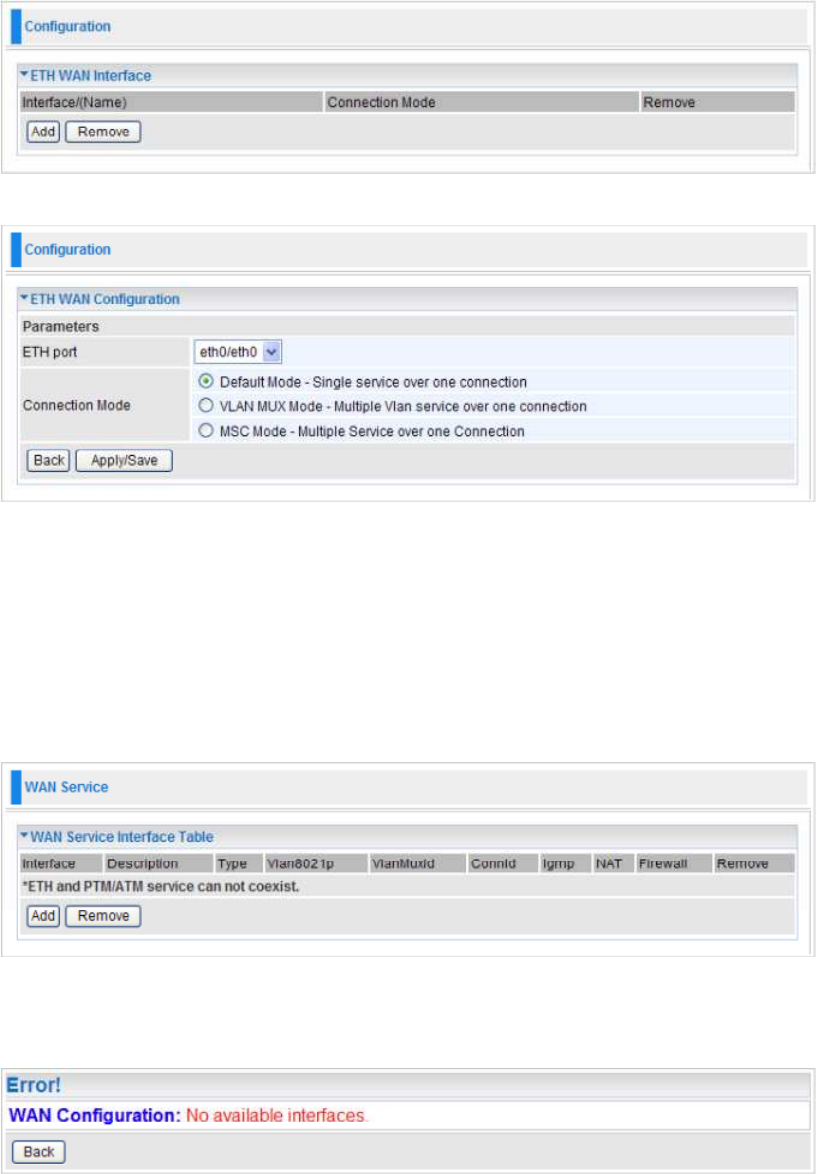
34
ETH Interface (EWAN)
Click Add to go to ETH WAN Configuration screen.
ETH port: Select the port for ETH WAN connection from the listbox.
Connection Mode: Choose a appropriate connection mode.
Click Apply/Save to save the changes or Back to return to ETH WAN Interface table.
WAN Service
Note: You have to set an interface at least previously. (Please refer to PTM Interface, ATM
Interface and ETH Interface sections. ETH and PTM/ATM service can not coexist.) If the WAN
interface has not set, a page will display as below and you are not allowd to create a WAN
connection.
Click Add to go to WAN Service Interface screen.
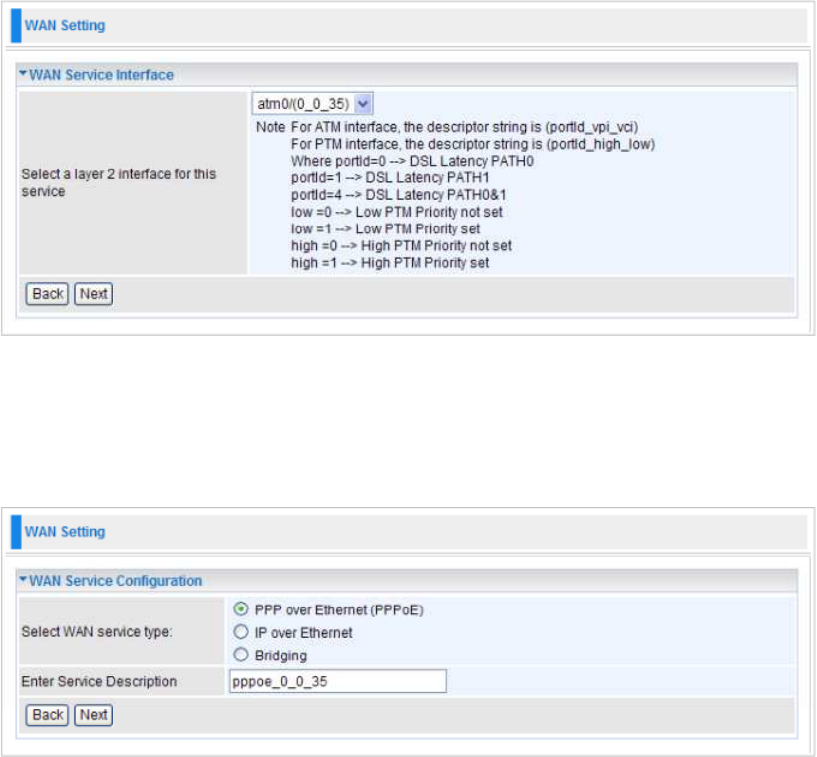
35
Select a layer2 interface form the drop-down menu for this service and then click on Next to continue.
PPP over Ethernet
PPPoE (PPP over Ethernet) provides access control in a manner similar to dial-up services using PPP.
Select WAN service type: Click PPP over Ethernet (PPPoE) radio button.
Enter Service Description: You are allowed to enter the user defined name for this service.
Click Next to go to next step.
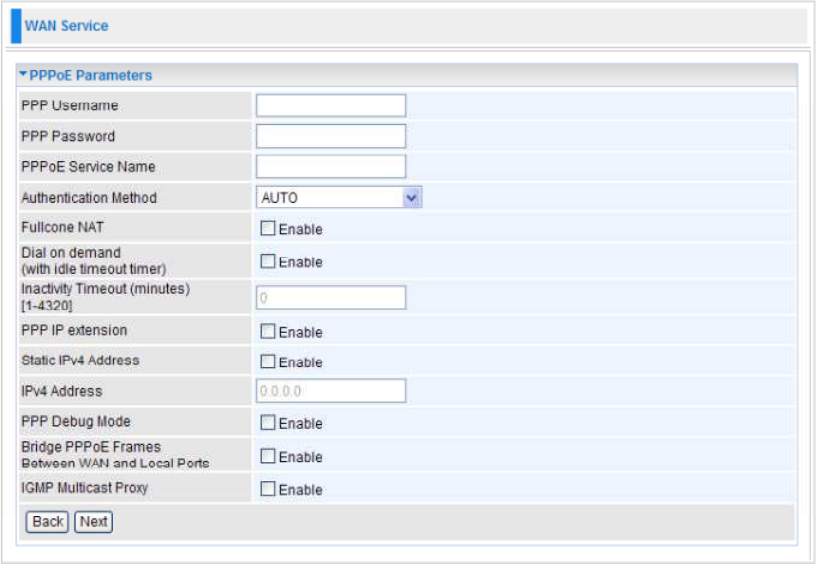
36
PPP Username: Enter the username provided by your ISP. You can input up to 256 alphanumeric
characters (case sensitive).
PPP Password: Enter the password provided by your ISP. You can input up to 32 alphanumeric
characters (case sensitive).
PPPoE Service Name: This item is for identification purposes. If it is required, your ISP will provide you
the necessary information. Maximum input is 32 alphanumeric characters.
Authentication Method: Default is AUTO. Please consult your ISP on whether to use PAP, CHAP or
MSCHAP.
Fullcone NAT: Check/uncheck this item to activate/inactivate this function.
Dial on demand (with idle timeout timer) / Inactivity Timeout (minutes) [1-4320]: Check Enable to
activate this function and the following field will be available, so that you can enter the time value to
auto-disconnect the broadband firewall gateway when there is no activity on the line for a predetermined
period of time.
PPP IP extension: Check/uncheck this item to enable/disable this function.
Static IPv4 Address / IPv4 Address: Check Enable to activate this function and the following field will
be available, so that you can enter the IPv4 address (default is 0.0.0.0) to the device.
PPP Debug Mode: Check/uncheck this item to enable/disable this function.
Bridge PPPoE Frames Between WAN and Local Ports: Check/uncheck this item to enable/disable
this function.
IGMP Multicast Proxy: Check/uncheck this item to enable/disable this function.
Click Next to go to next step.
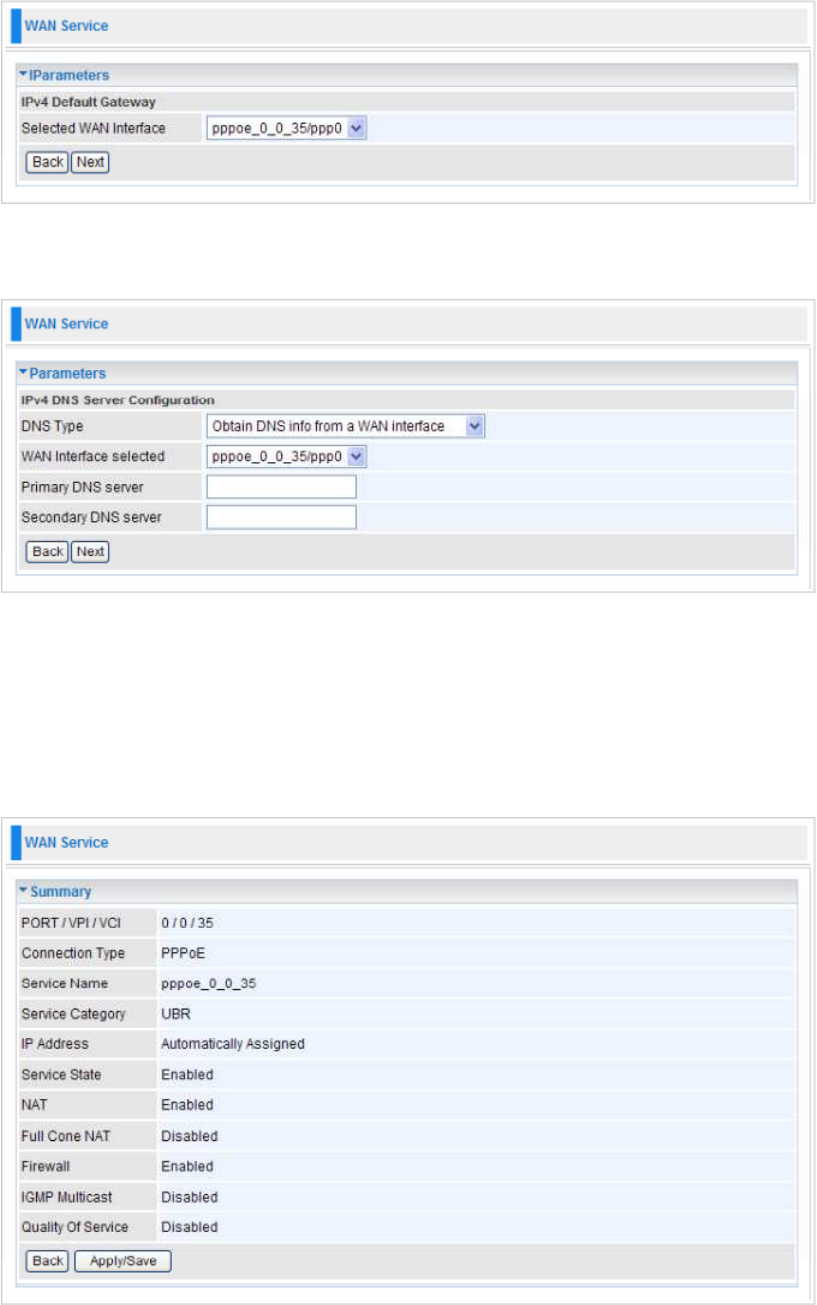
37
Selected WAN Interface: Select the WAN interface for the IPv4 Default Gateway.
Click Next to go to next step.
DNS Type: Select the appropriate DNS type.
WAN Interface selected: This field is available when DNS Type is "Obtain DNS info from a WAN
interface". Select a WAN interface for this device to obtain the DNS information.
Primary DNS server/Secondary DNS server: These fields are available when DNS Type is "Use the
following Static DNS IP address". Enter the primary/secondary DNS.
Click Next to go to next step.
This page lists a summary of previous steps. Make sure that the settings are the same as those provided
by your ISP and then click Apply/Save to complete the configuration process. Then you will return to
WAN Service Interface Table and this new profile will be displayed on this screen.
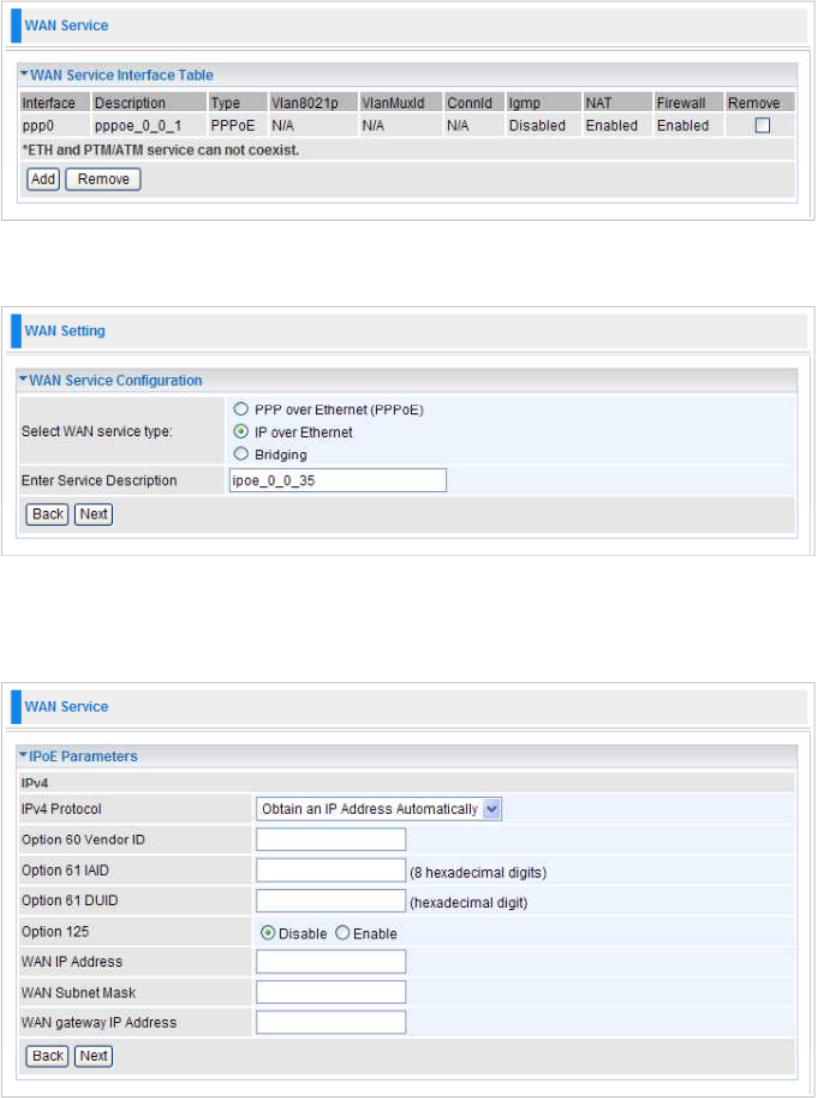
38
IP over Ethernet
Select WAN service type: Click IP over Ethernet radio button.
Enter Service Description: You are allowed to enter the user defined name for this service.
Click Next to go to next step.
IPv4 Protocol: Select the appropriate protocol. There are 2 options: Obtain an IP Address Automatically
and Fixed IP Address.
Option 60 Vendor ID: Enter the associated information provided by your ISP.
Option 61 IAID: Enter the associated information provided by your ISP. You should input 8 hexadecimal
numbers.
Option 61 DUID: Enter the associated information provided by your ISP. You should input hexadecimal
number(s).
Option 125: Check Enable or Disable this function. Default setting is Disable.
WAN IP Address: Enter your IP address to the device provided by your ISP. If Fixed IP Address is
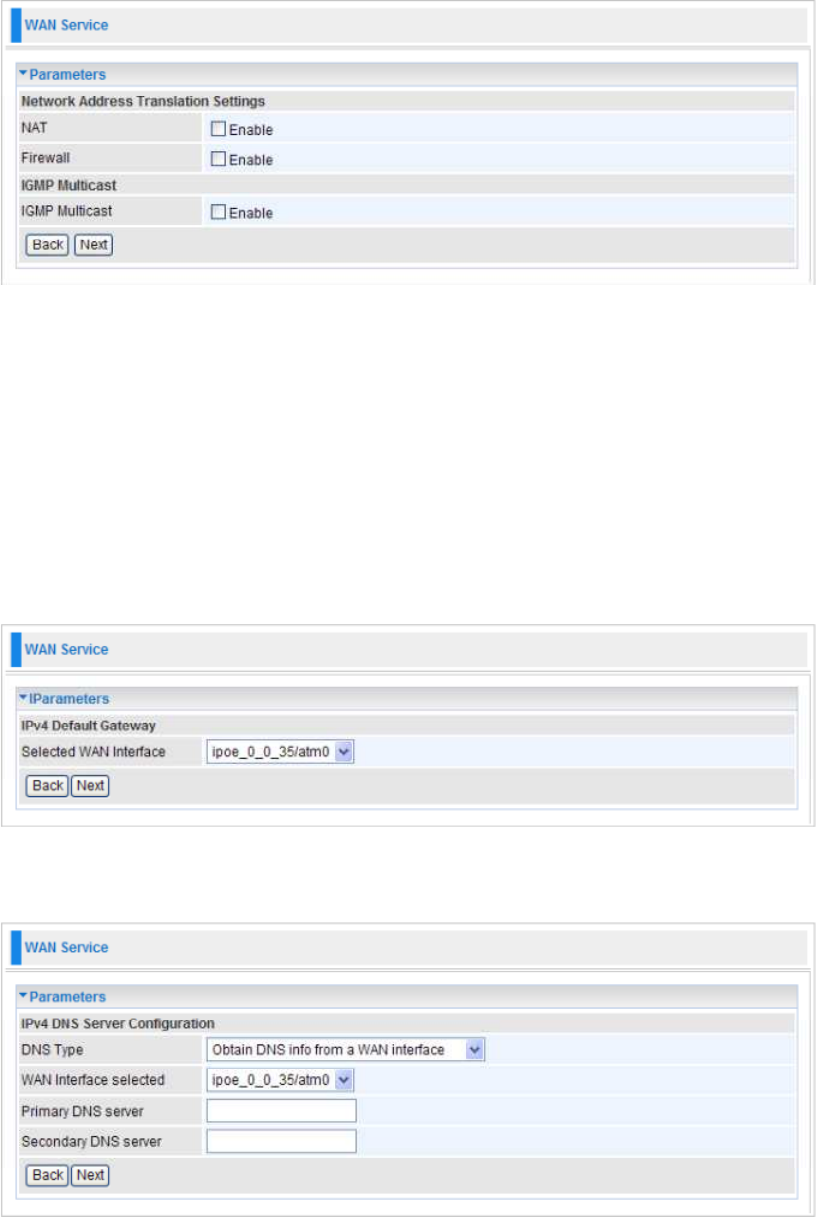
39
selected in the IPv4 Protocol field, default value 0.0.0.0 will display in this field.
WAN Subnet Mask: Enter your submask to the device provided by your ISP. If Fixed IP Address is
selected in the IPv4 Protocol field, default value 0.0.0.0 will display in this field.
WAN gateway IP Address: Enter your gateway IP address to the device provided by your ISP. If Fixed
IP Address is selected in the IPv4 Protocol field, default value 0.0.0.0 will display in this field.
Click Next to go to next step.
NAT: The NAT (Network Address Translation) feature allows multiple users to access the Internet
through a single IP account by sharing the single IP address. If users on your LAN have their own public
IP addresses to access the Internet, NAT function can be disabled.
Fullcone NAT: This filed will be displayed when you tick Enable on the NAT field. Check/uncheck this
item to activate/inactivate this function.
Firewall: Check/uncheck this item to enable/disable firewall function.
IGMP Multicast: IGMP (Internet Group Membership Protocol) is a protocol used by IP hosts to report
their multicast group memberships to any immediately neighboring multicast routers. Check this item to
enable IGMP multicast (proxy) on that wan interface for multicast forwarding.
Click Next to go to next step.
Selected WAN Interface: Select the WAN interface for the IPv4 Default Gateway.
Click Next to go to next step.
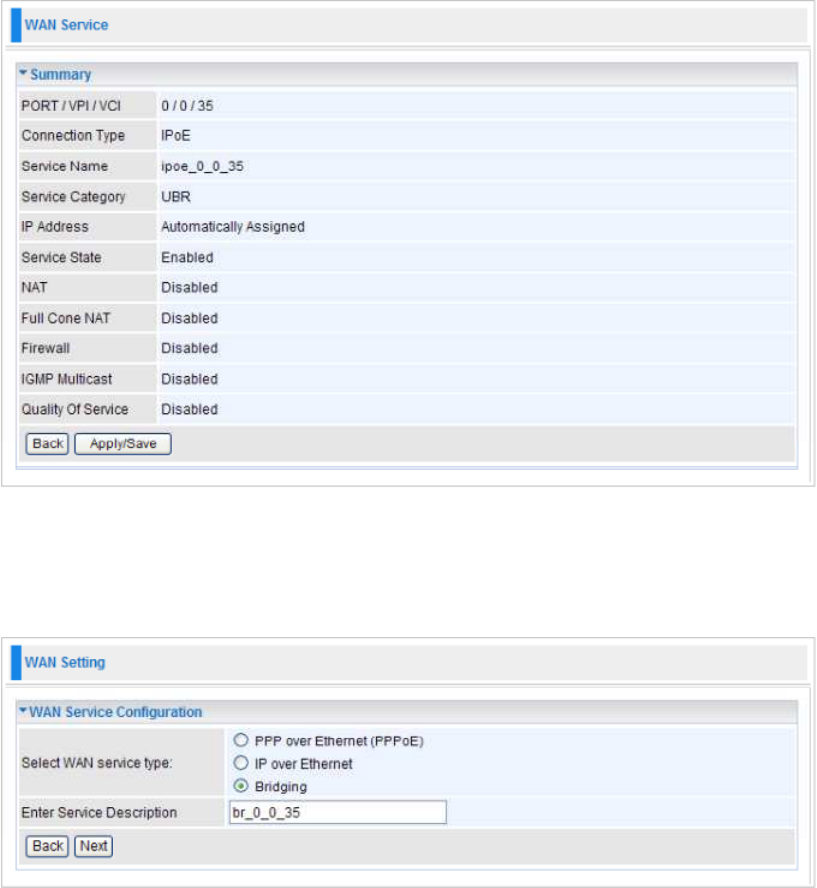
40
DNS Type: Select the appropriate DNS type.
WAN Interface selected: This field is available when DNS Type is "Obtain DNS info from a WAN
interface". Select a WAN interface for this device to obtain the DNS information.
Primary DNS server/Secondary DNS server: These fields are available when DNS Type is "Use the
following Static DNS IP address". Enter the primary/secondary DNS.
Click Next to go to next step.
This page lists a summary of previous steps. Make sure that the settings are the same as those provided
by your ISP and then click Apply/Save to complete the configuration process.
Bridging
Select WAN service type: Click Bridging radio button.
Enter Service Description: You are allowed to enter the user defined name for this service.
Click Next to go to next step.
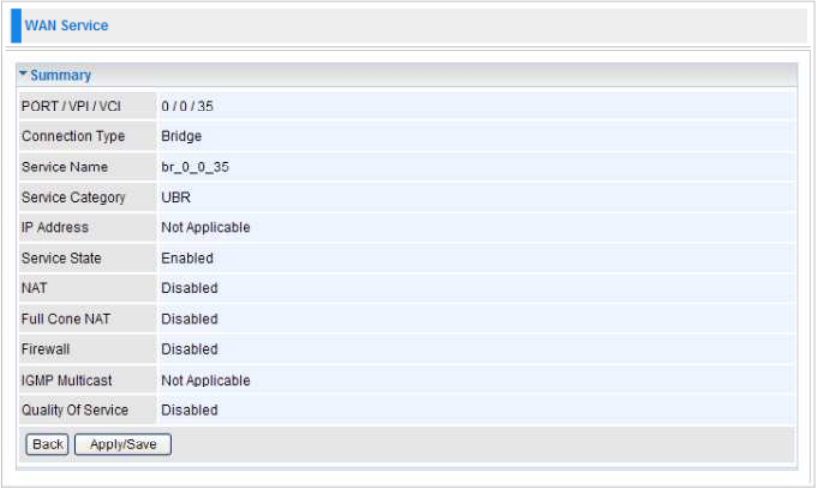
41
This page lists a summary of previous steps. Make sure that the settings are the same as those provided
by your ISP and then click Apply/Save to complete the configuration process.
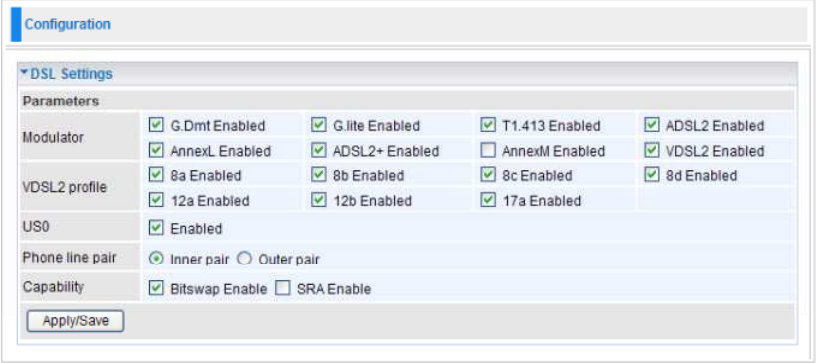
42
DSL
This screen allows you to set DSL parameters. DSL knowledge is required to configure these settings.
Contact your ISP to make sure that these parameters are correct.
Modulation: There are 8 modes “G.Dmt”, “G.lite”, “T1.413”, “ADSL2”, “AnnexL”, ”ADSL2+”, “AnnexM”,
and “VDSL2” that user can select for this connection.
G.Dmt/G.lite Enabled: Tick the G.Dmt/G.lite check box if you want the system to use either
G.Dmt or G.lite mode.
T1.413 Enabled: Tick the T1.413 check box if you want the system to use only T1.413 mode.
ADSL2 Enabled: The device can support the functions of the ADSL2.
AnnexL Enabled: The device can support/enhance the long loop test.
ADSL2+ Enabled: The device can support the functions of the ADSL2+.
AnnexM Enabled: Covers a higher “upstream” data rate version, by making use of some of the
downstream channels.
VDSL2 Enabled: The device can support the functions of the VDSL2.
VDSL2 profile: There are 7 profiles “8a”, “8b”, “8c”, ”8d”, “8a”, “12a”, “12b” and “17a” that user can select
for this connection.
US0: Check/uncheck this item to enable/disable this function.
Phone line pair: This is for reserved only. You can choose "Inner Pair" or "Outer Pair".
Capability: There are 2 options “Bitswap Enable” and “SRA Enable” that user can select for this
connection.
Bitswap Enable: Allows bitswaping function.
SRA Enable: Allows seamless rate adaptation.
Click Apply/Save to confirm the changes.
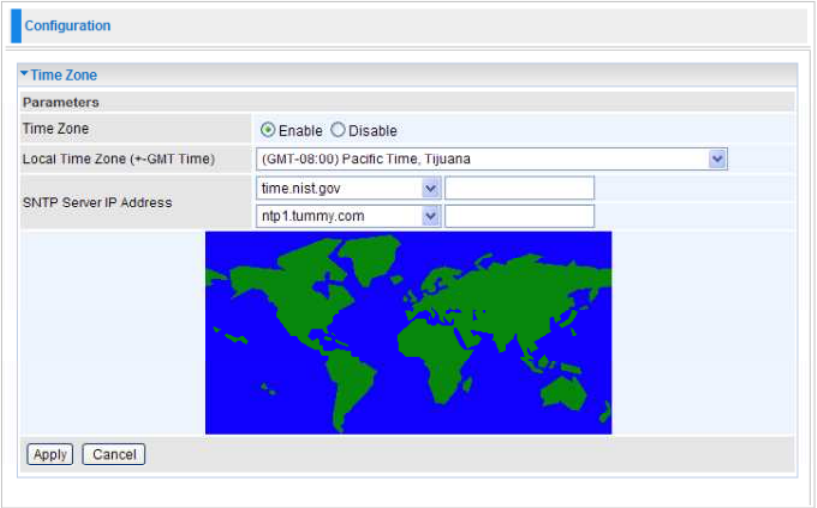
43
System
There are 5 items within the System section: Time Zone, Firmware Upgrade, Backup/Restore,
Restart and User Management.
Time Zone
Enable or disable the time zone function. If you disable time zone, the other blanks are unavailable.
The router does not have a real time clock on board; instead, it uses the Simple Network Time Protocol
(SNTP) to get the most current time from an SNTP server outside your network. Choose your local time
zone from the drop down menu. To apply the selected local time zone, click Enable and click the Apply
button. After a successful connection to the Internet, the router will retrieve the correct local time from the
SNTP server you have specified. If you prefer to specify an SNTP server other than those in the
drop-down list, simply enter its IP address in their appropriate blanks provided as shown above. Your
ISP may also provide an SNTP server for you to use.
Click Apply to confirm the settings.
The router does not have a real time clock on board; instead, it uses the Simple Network Time Protocol
(SNTP) to get the most current time from an SNTP server outside your network. Choose your local time
zone from the drop down menu. To apply the selected local time zone, click Enable and click the Apply
button. After a successful connection to the Internet, the router will retrieve the correct local time from the
SNTP server you have specified. If you prefer to specify an SNTP server other than those in the
drop-down list, simply enter its IP address in their appropriate blanks provided as shown above. Your
ISP may also provide an SNTP server for you to use.
Click Apply to confirm the settings.
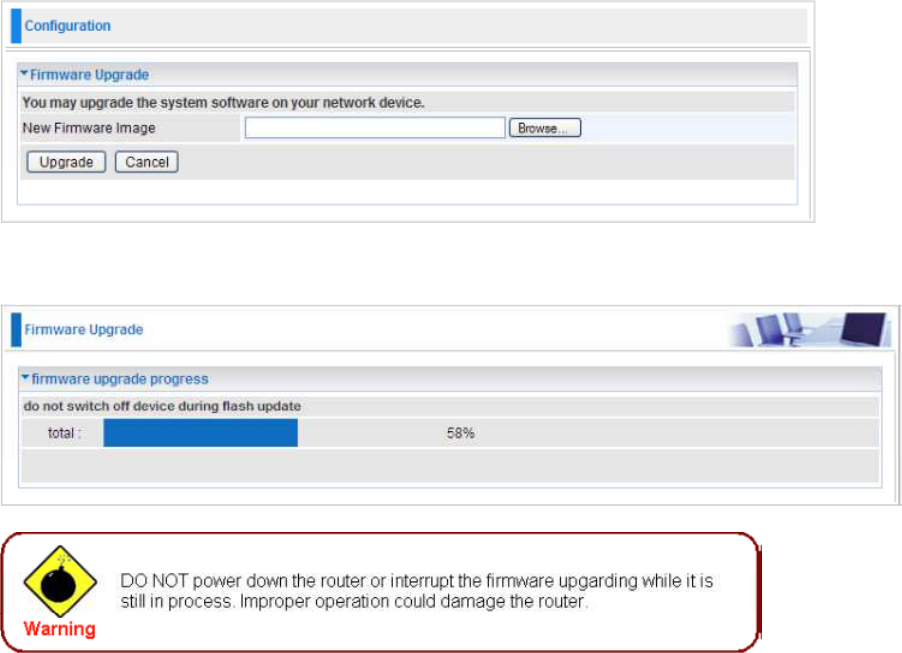
44
Firmware Upgrade
Your router’s firmware is the software that enables it to operate and provides all its functionality. Think of
your router as a dedicated computer, and the firmware as the software that runs in your router. Thus, by
upgrading the newly improved version of the firmware allows you the advantage to use newly integrated
features.
Click on Browse to select the new firmware image file you have downloaded to your PC. Once the
correct file is selected, click Upgrade to update the firmware to your router.
Backup / Restore
These functions allow you to save a backup of the current configuration of your router to a defined
location on your PC, or to restore a previously saved configuration. This is useful if you wish to
experiment with different settings, knowing that you have a backup in hand in case any mistakes occur.
It is advisable that you backup your router configuration before making any changes to your router
configuration.
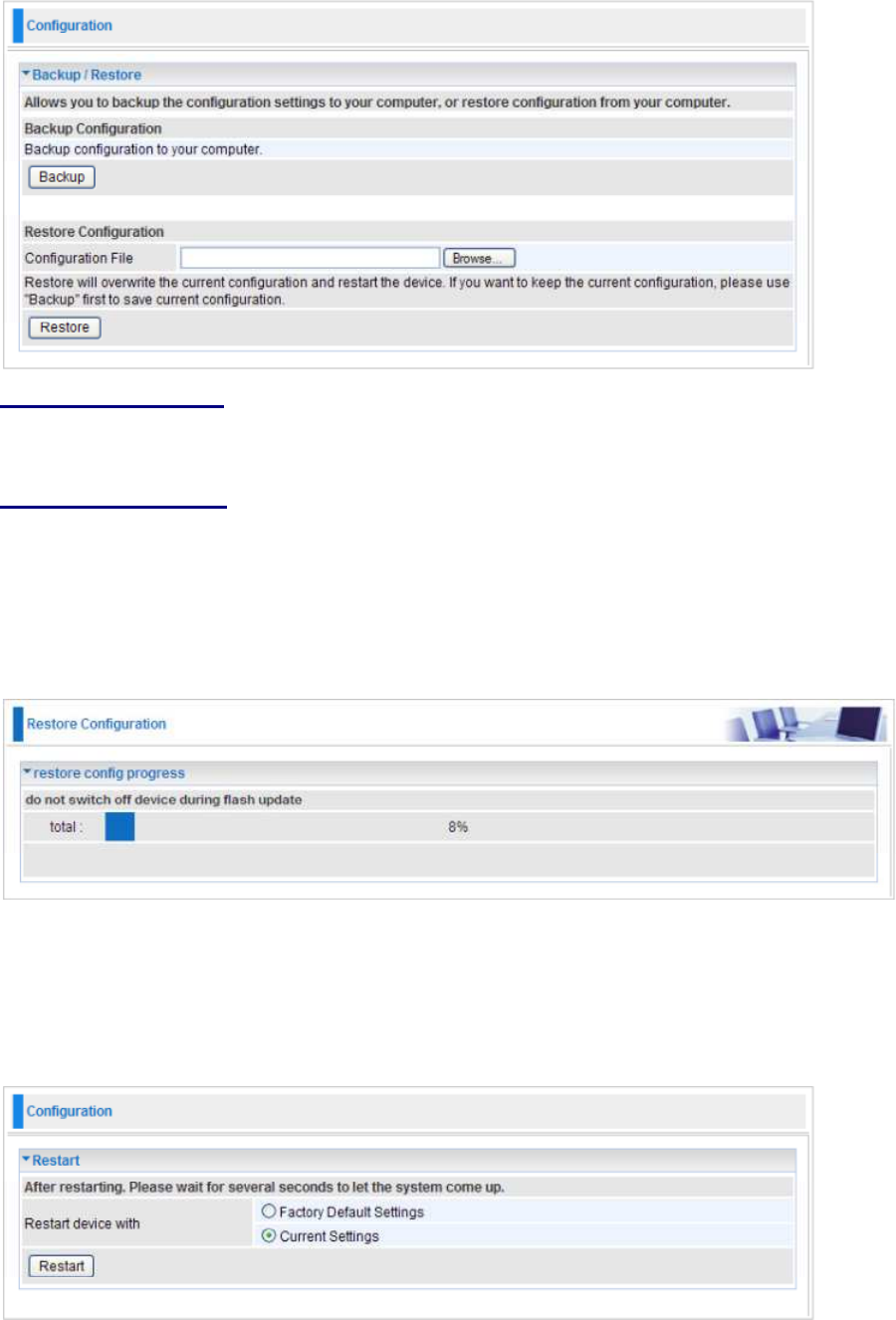
45
Backup Configuration
Press Backup Settings to select where on your local PC you want to store your setting file. You may also
want to change the name of the file when saving if you wish to keep multiple backups.
Restore Configuration
Press Browse to select a file from your PC to restore. You should only restore your router setting that has
been generated by the Backup function which is created with the current version of the router firmware.
Settings files saved to your PC should not be manually edited in any way.
Select the settings files you wish to use, and press Restore to load the setting into the router. Click
Restore to begin restoring the configuration and wait for the router to restart before performing any
actions.
Restart
There are 2 options for you to choose from before restarting your device. You can either choose to
restart your device to restore it to the Factory Default Settings or to restart the device with your current
settings applied. Restarting your device to Factory Default Setting will be useful especially after you have
accidentally changed your settings that may result in undesirable outcome.
If you wish to restart the router using the factory default settings (for example, after a firmware upgrade
or if you have saved an incorrect configuration), select Factory Default Settings to reset to factory default
settings.
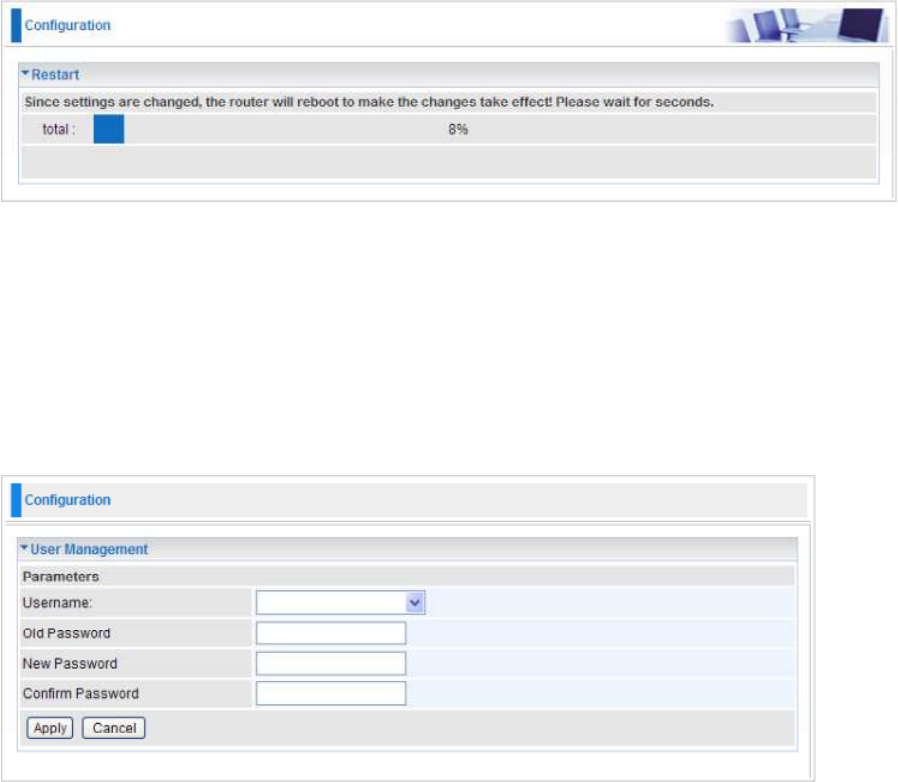
46
Click Restart with option Current Settings to reboot your router (and restore your last saved
configuration).
After selecting the type of setting you want the device to restart with, click the Restart button to initiate the
process. After restarting, please wait several minutes to let the selected setting applied to the system.
You may also reset your router to factory settings by holding the small Reset pinhole button more than 1
second on the back of your router.
52
User Management
In order to prevent unauthorized access to your router configuration interface, it requires all users to login
with a username and password. Therefore only system administrator can access the system. It is highly
recommended that you change your password upon receiving your router. The default password is
“admin”.
Select the username you want to configure from the drop-down menu and then set the associated
password.
To change your password, simply enter the old password in the Old Password blank. Then enter your
new password in the New Password and Confirm Password blanks provided. When this is done, press
Apply to save changes.
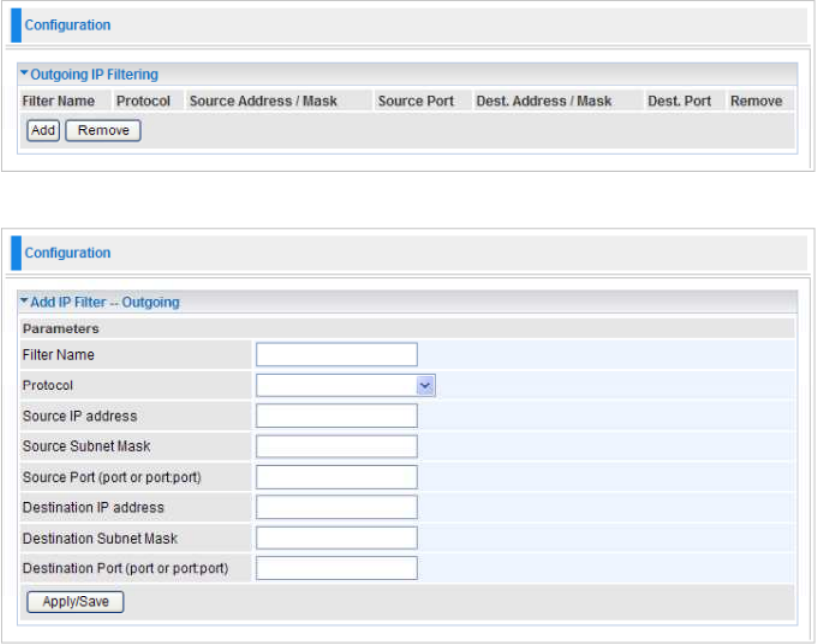
47
Firewall
Listed are the items under the Firewall section: IP Filtering, MAC Filtering and Parental Control.
IP Filtering
Packet filtering enables you to configure your router to block specific internal / external users (IP address)
from Internet access, or disable specific service requests (Port number) to / from the Internet. This
configuration program allows you to set up different filter rules for different users based on their IP
addresses or their network port number. The relationship among all filters is “or” operation, which means
that the router checks these different filter rules one by one, starting from the first rule. As long as one of
the rules is satisfied, the specified action will be taken.
Outgoing
All outgoing IP traffic from LAN is allowed by default, but some IP traffic could be blocked by setting up
filters.
Click Add to enter Add IP Filter -- Outing screen to create a filter to identify the outgoing IP traffic.
Filter Name: User defined description for entry identification. The maximum name length is 32
characters.
Protocol: Specify the packet type (TCP/UDP, TCP, UDP and ICMP) that the rule applies to from
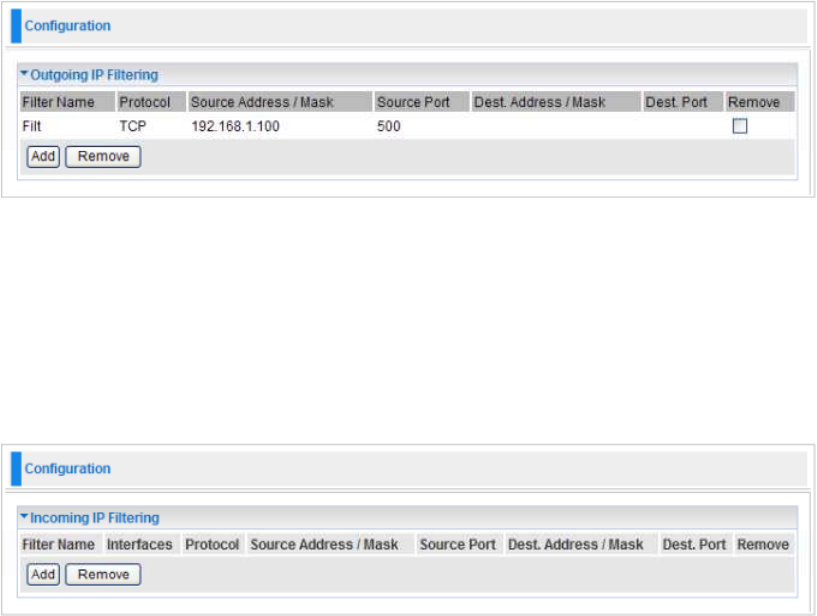
48
the listbox. Select TCP if you wish to search for the connection-based application service on the remote
server using the port number. Or select UDP if you want to search for the connectionless application
service on the remote server using the port number.
Source IP address: This is an Address-Filter used to allow or block traffic from particular IP address(es).
Enter the IP range that you want to filter. If only the first IP block is filled, it means only that IP entered will
be targeted. If you leave both IP blocks empty, it means any IP address.
Source Subnet Mask: Type the subnet mask associated with the source IP address.
Source Port (port to port:port): This is the Port Range that defines the ports allowed by the
Remote/WAN to connect to the application. It is recommended that only advance user is to configure this
feature.
Destination IP address: This is an Address-Filter used to allow or block traffic to particular IP
address(es). Enter the IP range that you want to filter. If only the first IP block is filled, it means only that
IP entered will be targeted. If you leave both IP blocks empty, it means any IP address.
Destination Subnet Mask: Type the subnet mask associated with the Destination IP address.
Destination Port (port to port:port): This is the Port Range that defines the port of the application.
Click Apply/Save to set the new settings and you will be returned to the Outgoing IP Filtering page.
Remove: To delete the IP filtering rule from the table, check Remove checkbox then click Remove
button to delete the selected item.
Incoming
All incoming IP traffic from the WAN is blocked by default when the firewall is enabled. However, some IP
traffic can be accepted by setting up filters.
Click Add to enter Add IP Filter -- Incoming screen to add a filter rule for incoming IP traffic.
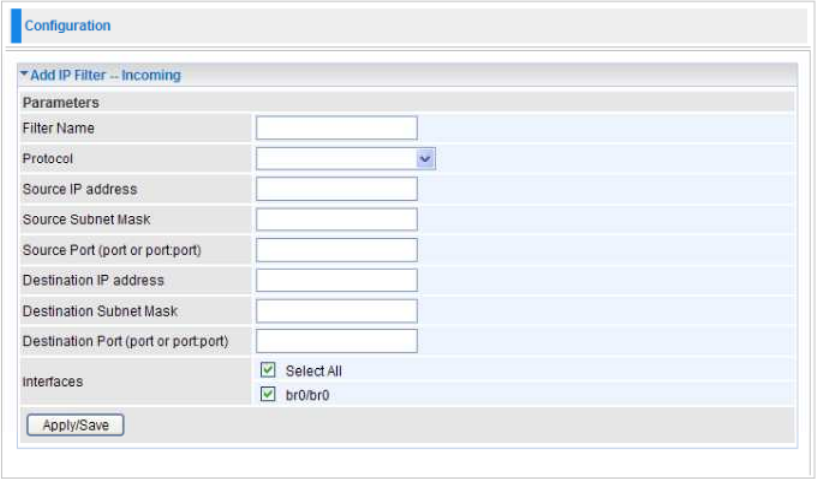
49
Filter Name: User defined description for entry identification. The maximum name length is 32
characters
Protocol: Specify the packet type (TCP/UDP, TCP, UDP and ICMP) that the rule applies to from the
listbox. Select TCP if you wish to search for the connection-based application service on the remote
server using the port number. Or select UDP if you want to search for the connectionless application
service on the remote server using the port number.
Source IP address: This is an Address-Filter used to allow or block traffic from particular IP address(es).
Enter the IP range that you want to filter. If only the first IP block is filled, it means only that IP entered will
be targeted. If you leave both IP blocks empty, it means any IP address.
Source Subnet Mask: Type the subnet mask associated with the source IP address.
Source Port (port to port:port): This is the Port Range that defines the ports allowed by the
Remote/WAN to connect to the application. It is recommended that only advance user is to configure this
feature.
Destination IP address: This is an Address-Filter used to allow or block traffic to particular IP
address(es). Enter the IP range that you want to filter. If only the first IP block is filled, it means only that
IP entered will be targeted. If you leave both IP blocks empty, it means any IP address.
Destination Subnet Mask: Type the subnet mask associated with the Destination IP address.
Destination Port (port to port:port): This is the Port Range that defines the port of the application.
Interfaces: Check the check box to select the interface for this rule.
Click Apply/Save to set the new settings and you will be returned to the Incoming IP Filtering page.
Remove: To delete the IP filtering rule from the table, check Remove checkbox then click Remove
button to delete the selected item.
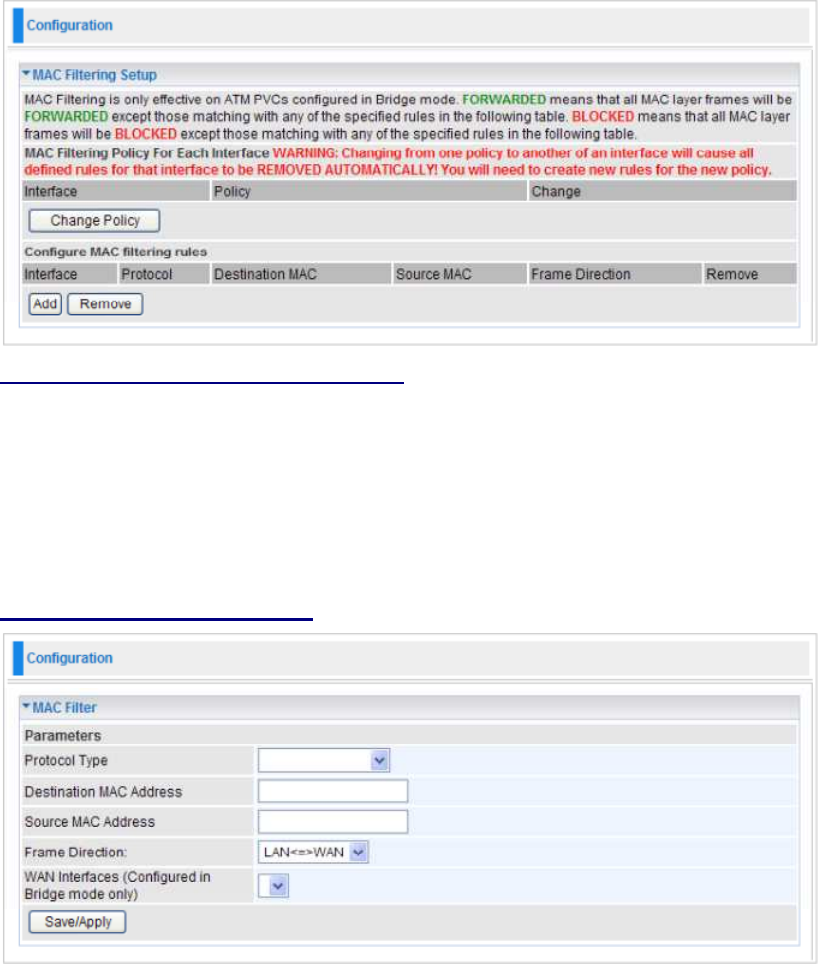
50
MAC Filtering
A MAC (Media Access Control) address is the unique network hardware identifier for each PC on your
network’s interface (i.e. its Network Interface Card or Ethernet card). Using your router’s MAC Address
Filter function, you can configure the network to block specific machines from accessing your LAN.
MAC Filtering Policy For Each Interface
MAC Filtering is only effective on ATM PVCs configured in Bridge mode. FORWARD means that all
MAC layer frames will be FORWARDED except those matching with any of the specified rules in the
following table. BLOCKED means that all MAC layer frames will be BLOCKED except those matching
with any of the specified rules in the following table.
Note: Changing from one policy to another of an interface will cause all defined rules for that
interface to be REMOVED AUTOMATICALLY! You will need to create new rules for the new
policy.
Configure MAC Filtering Rules
To create a filter to identify the MAC layer frames, click on Add button.
You should specify at least one condition below to set a MAC filter profile. If multiple conditions are
specified, all of them take effect.
Protocol Type: Select which protocol this filter will be applied to from the drop-down menu.
Destination MAC Address: Enter the destination MAC address this filter will be applied to. The format
of MAC address could be: xx:xx:xx:xx:xx:xx or xx-xx-xx-xx-xx-xx.
Source MAC Address: Enter the origin MAC address this filter will be applied to. The format of MAC
address could be: xx:xx:xx:xx:xx:xx or xx-xx-xx-xx-xx-xx.
Frame Direction: Select the frame flow direction from the listbox: LAN to WAN, WAN to LAN, or both
51
directions.
WAN Interfaces (Configured in Bridge mode only): Select the WAN interface.
Click Apply/Save to set the new settings and you will be returned to the Incoming IP Filtering page.
Remove: To delete the IP filtering rule from the table, check Remove checkbox then click Remove
button to delete the selected item.
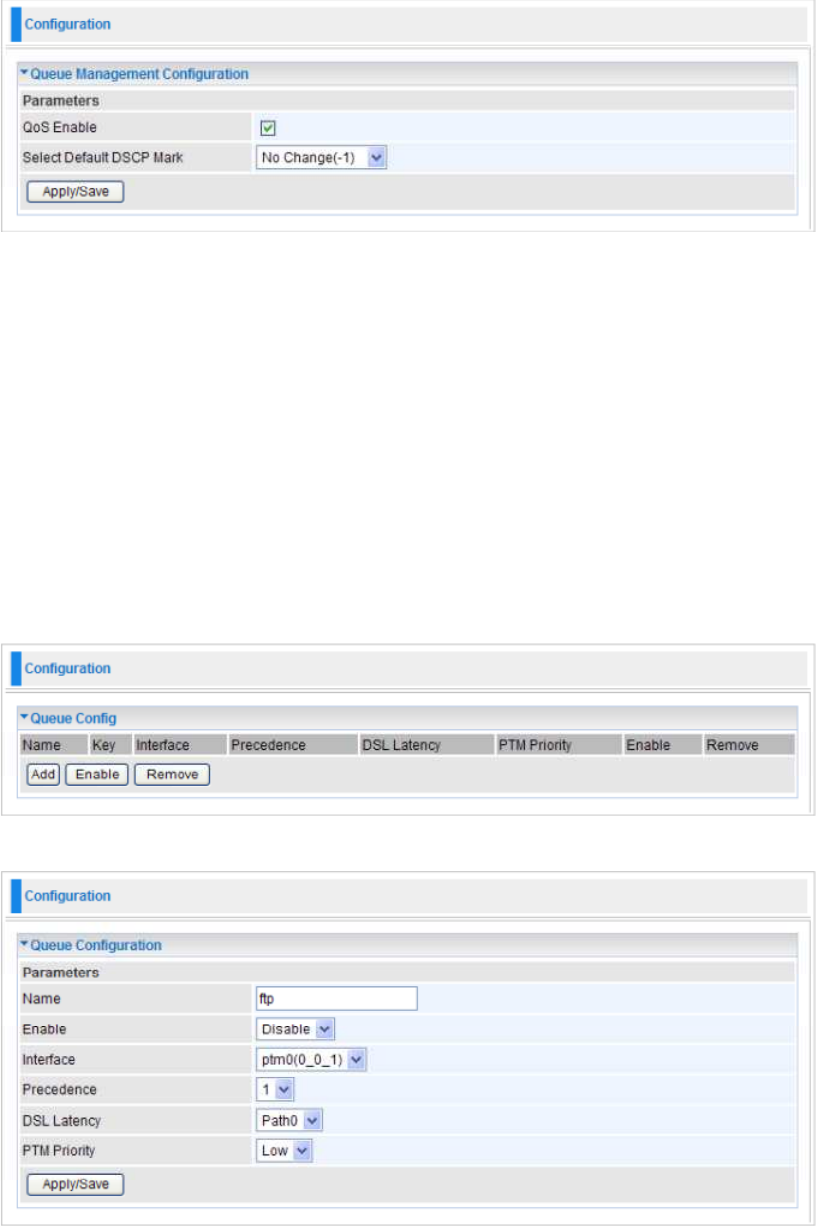
52
QoS - Quality of Service
QoS helps you to control the data upload traffic of each application from LAN (Ethernet) to WAN
(Internet). It facilitates you the features to control the quality and speed of throughput for each application
when the system is running with full upstream load.
QoS Enable: Check to activate QoS function and the following field will be available.
Note: You can enable QoS function in WAN Configuration pages by checking “Enable Quality of
Service.” check box (refer to Layer2 Interface section).
Select Default DSCP Mark: Select the default DSCP mark from the listbox. Differentiated Services
Code Point (DSCP) is the first 6 bits in the ToS byte. DSCP Mark allows users to classify the traffic of the
application to be executed according to the DSCP value.
Click Apply/Save to confirm the settings.
Queue Config
Queue Config allows you to configurate a QoS queue entry and assign it to a specific network interface.
Each queue entry set here will be used by the classfier to place ingress packets appropriately.
Click Add to create the queue.
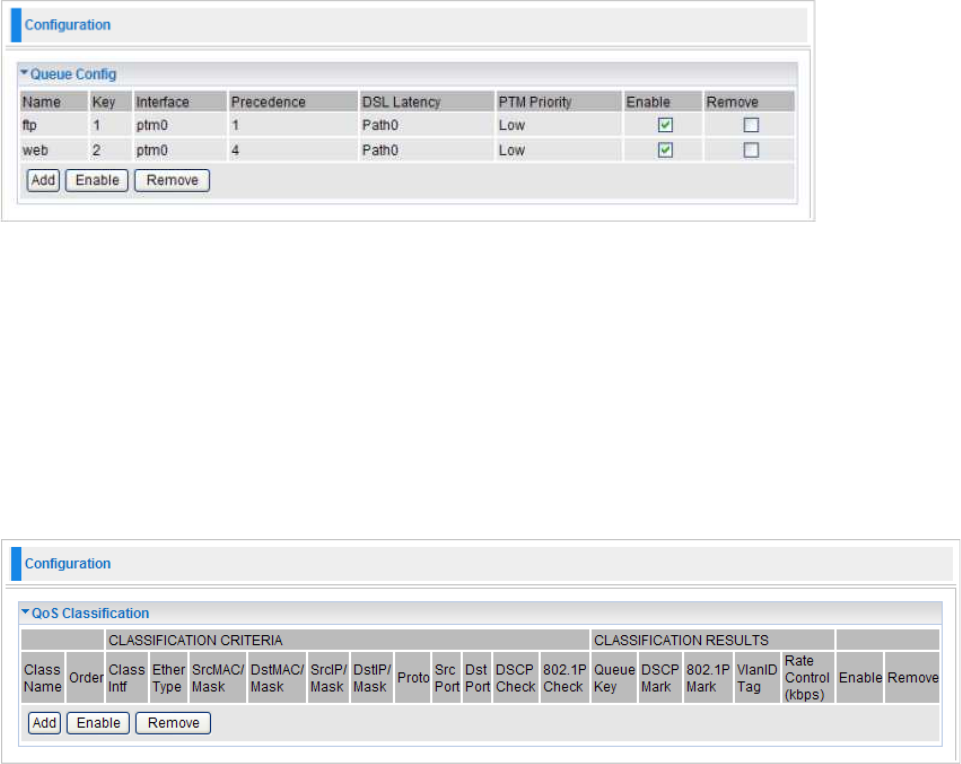
53
Name: Enter a name for this QoS item.
Enable: Select enable or disable this QoS application.
Interface: Select the interface you want to assign to this QoS item.
Precedence: Select the precedence of this QoS item. The rule is performed by selecting the order of the
rules. The highest priority is 1.
DSL Latency: Select the DSL latency.
PTM Priority: Select the priority given to fit PTM policy/application.
Click Apply/Save to confirm the settings and you will be returned to the Queue Config table.
Enable: To disable the item, please uncheck Enable check box then click Enable button.
Remove: To delete the QoS rule from the table, check Remove checkbox then click Remove button to
delete the selected item.
QoS Classification
This screen displays a packet QoS summary table and allows user to add or remove a QoS classification
class. This is the main place to configure the classification, marking and queuing rules.
Click Add to configure network traffic classes.
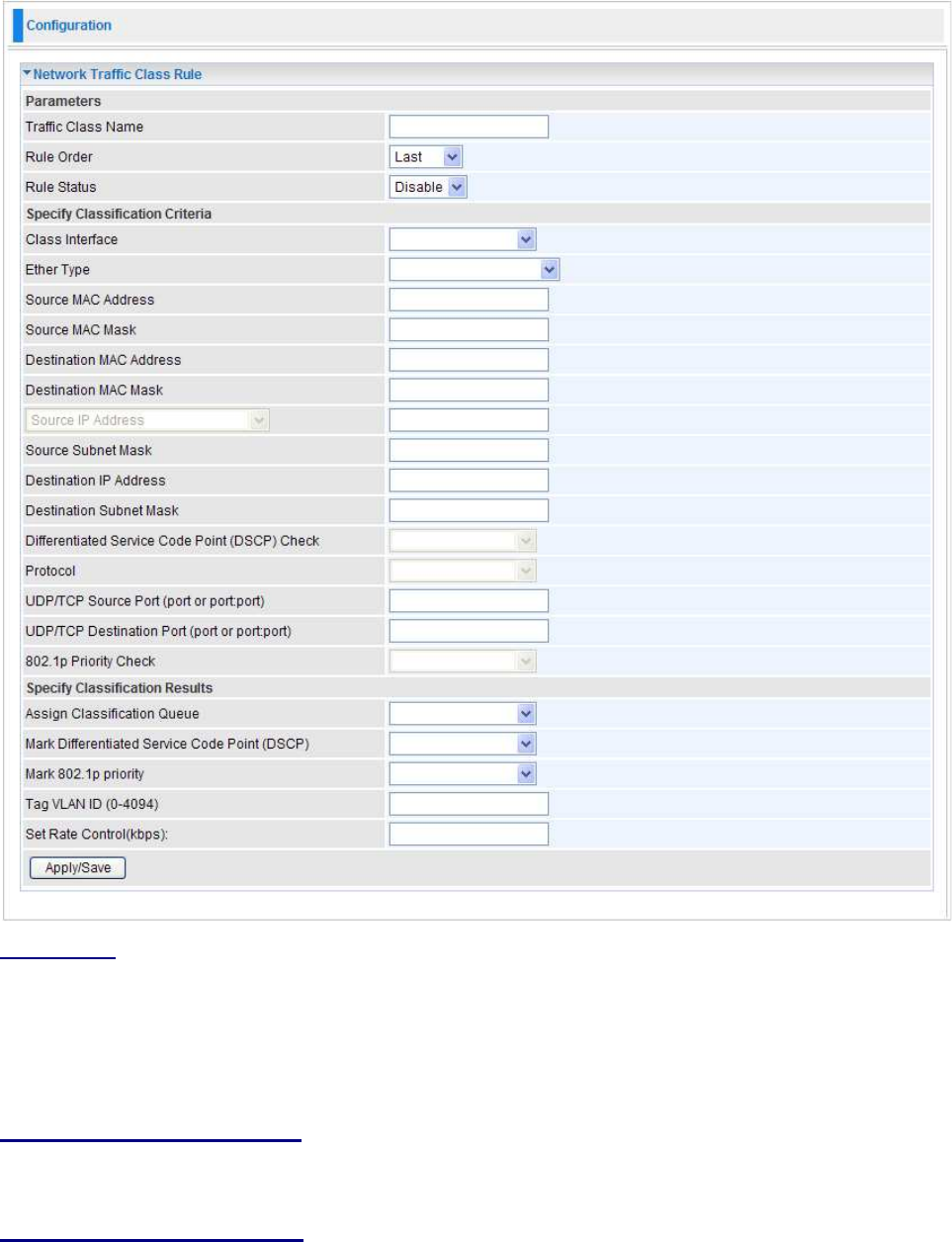
54
Parameters
Traffic Class Name: Assign a name for this class to uniquely identify the other(s) among multiple
classes.
Rule Order: Select the priority for this class rule.
Rule Status: Select Enable to activate this class rule.
Specify Classification Criteria
Enter or select appropriate parameters on the following fields. A blank criterion indicates it is not used for
classification.
Specify Classification Results
Enter or select appropriate parameters in the following fields. You have to choose a classification queue.
A blank mark or tag value means no change.
Click Apply/Save to confirm the settings and you will be returned to the QoS Classification page.
Enable: To disable the item, please uncheck Enable check box then click Enable button.
55
Remove: To delete the QoS class from the table, check Remove checkbox then click Remove button to
delete the selected item.

56
Virtual Server
Virtual Server allows you to direct incoming traffic from WAN side (identified by Protocol and External
port) to the Internal server with private IP address on the LAN side. The Internal port is required only if
the external port needs to be converted to a different port number used by the server on the LAN side.
In TCP and UDP networks a port is a 16-bit number used to identify which application program (usually a
server) incoming connections should be delivered to. Some ports have numbers that are pre-assigned to
them by the IANA (the Internet Assigned Numbers Authority), and these are referred to as “well-known
ports”. Servers follow the well-known port assignments so clients can locate them.
If you wish to run a server on your network that can be accessed from the WAN (i.e. from other machines
on the Internet that are outside your local network), or any application that can accept incoming
connections (e.g. Peer-to-peer/P2P software such as instant messaging applications and P2P
file-sharing applications) and are using NAT (Network Address Translation), then you need to configure
your router to forward these incoming connection attempts using specific ports to the PC on your network
running the application. You also need to use port forwarding if you wish to host an online game server.
Examples of well-known and registered port numbers are shown below, for further information, please
see IANA’s website at: http://www.iana.org/assignments/port-numbers
Well-known and Registered Ports
Port Number Protocol Description
20 TCP FTP Data
21 TCP FTP Control
22 TCP & UDP SSH Remote Login Protocol
23 TCP TElnet
25 TCP SMTP (simple Mail Transfer Protocol)
53 TCP & UDP DNS (Domain Name Server)
69 UDP TFTP (Trivial File Transfer Protocol)
80 TCP World Wide Web HTTP
110 TCP POP3 (Post Office Protocol version 3)
119 TCP NEWS (Network News Transfer Protocol)
123 UDP NTP (Network Time Protocol)
161 TCP SNMP
443 TCP & UDP HTTPS
1503 TCP T.120
1720 TCP H.323
4000 TCP ICQ
7070 UDP Real Audio
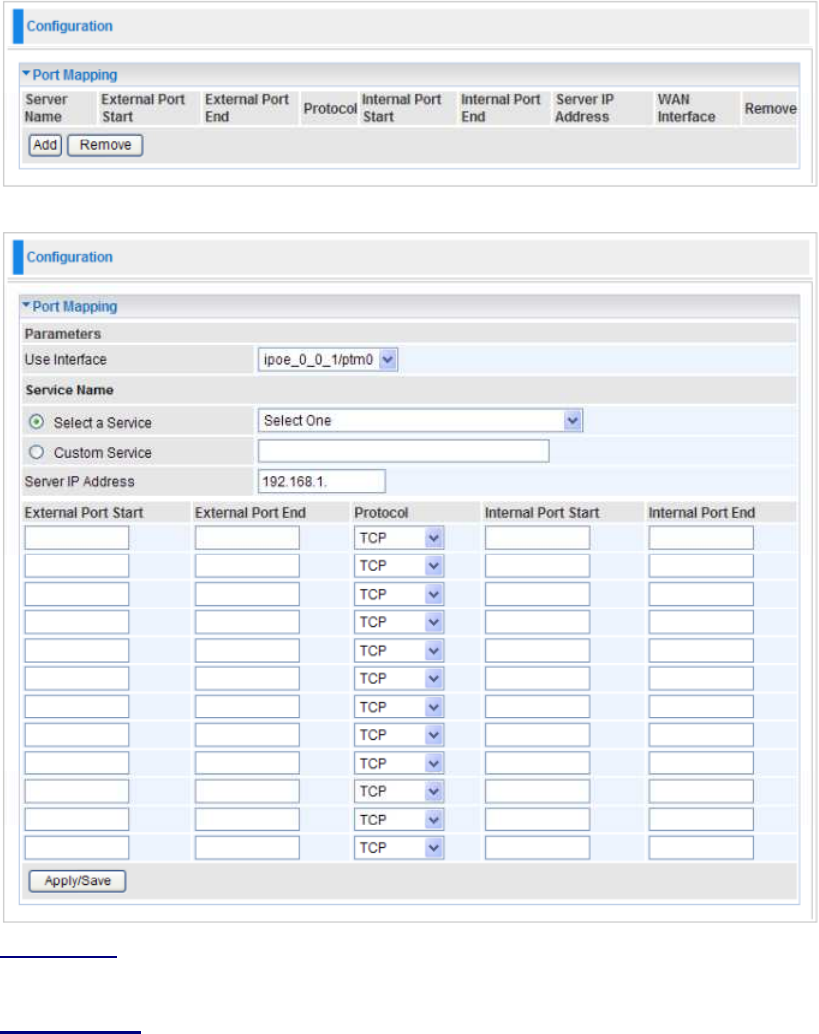
57
Port Mapping
Click Add to enter Port Mapping configuration screen.
Parameters
Use Interface: Select a interface which you want from the frop-down menu.
Service Name
Choose the service you need for this server. If you choose Select a Service, select an application from
the listbox. If you choose Custom Service, enter a given name for this service.
Server IP Address: Enter the IP address.
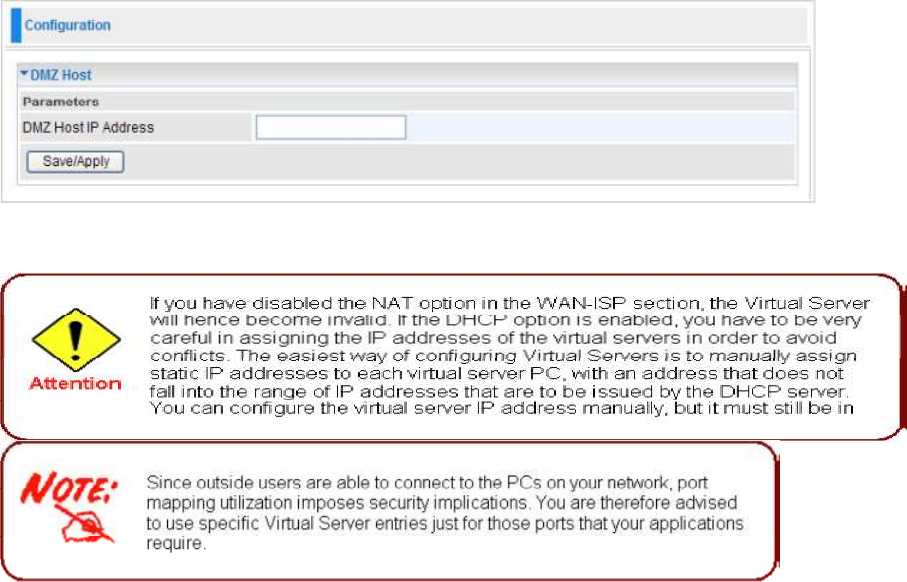
58
External Port Start / External Port End: Enter the public port number & range you wish to configure.
Protocol: In addition to specifying the port number used, you also need to specify the protocol used. The
protocol is determined by a particular application. Most applications use TCP or UDP, however you may
also specify other protocols using the drop-down Protocol menu.
Internal Port Start / Internal Port End: Enter the public port number & range you wish to configure.
Click Apply/Save to confirm the settings and you will be returned to Port Mapping table.
Remove: To delete the port mapping entry from the table, check Remove checkbox then click Remove
button to delete the selected item.
Since NAT acts as a “natural” Internet firewall, your router protects your network from accessed by
outside users, as all incoming connection attempts point to your router unless you specifically create
Virtual Server entries to forward those ports to a PC on your network. When your router needs to allow
outside users to access internal servers, e.g. a web server, FTP server, Email server or game server, the
router can act as a “virtual server”. You can set up a local server with a specific port number for the
service to use, e.g. web/HTTP (port 80), FTP (port 21), Telnet (port 23), SMTP (port 25), or POP3 (port
110). When an incoming access request the router for a specified port is received, it is forwarded to the
corresponding internal server.
For example, if you set the port number 80 (Web/HTTP) to be mapped to the IP Address 192.168.1.2,
then all incoming HTTP requests from outside users are forwarded to the local server (PC) with the IP
address of 192.168.1.2. If the port is not listed as a predefined application, you need to add it manually.
DMZ Host
The DMZ Host is a local computer exposed to the Internet. When setting a particular internal IP address
as the DMZ Host, all incoming packets that do not use a port number which is already used by any other
Virtual Server entries will first be checked by the Firewall and NAT algorithms before it is passed to the
DMZ host. When this is done, press Apply to save the changes.
DMZ Host IP Address: Enter the computer's IP address and click Save/Apply to activate the DMZ host.
Or you can clear this field and click Save/Apply to inactivate the DMZ host.
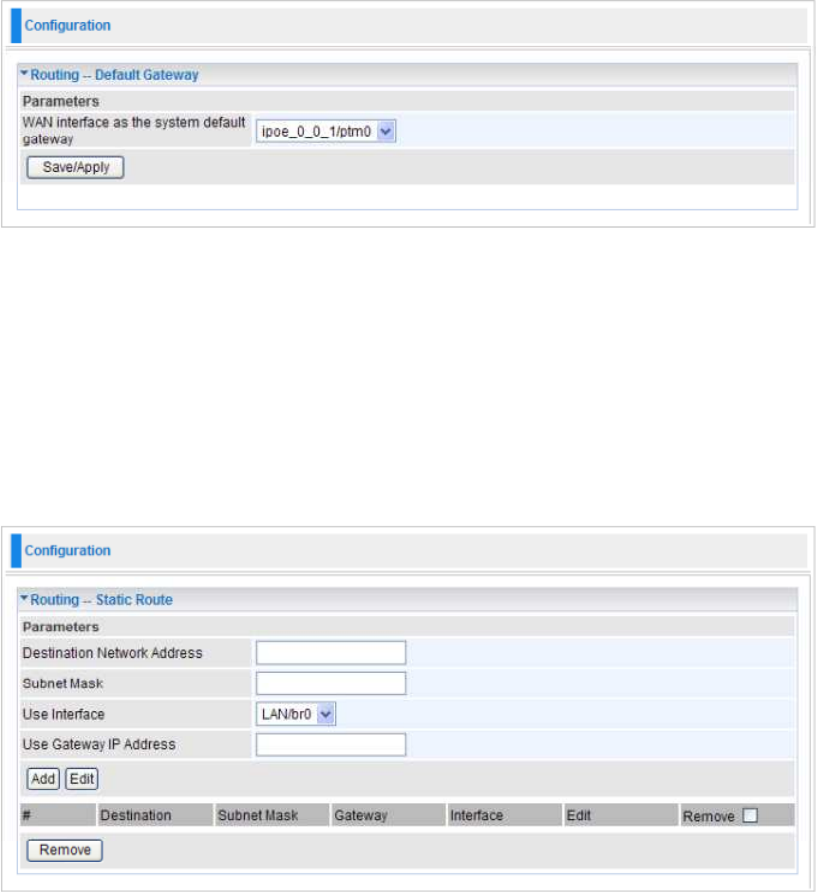
59
Advanced
Configuration options within the Advanced section are for users who wish to take advantage of the more
advanced features of the router. Users who do not understand the features should not attempt to
reconfigure their router, unless advised to do so by support staff.
Here are the items within the Advanced section: Routing, DNS, Interface Grouping, Device
Management, System Log Server and TR-069 client.
Routing
Default Gateway
WAN interface as the system default gateway: Select an appropriate WAN interface as the default
gateway.
Click Save/Apply to confirm the settings.
Static Route
With static route feature, you are equipped with the capability to control the routing of the all the traffic
across your network. With each routing rule created, you can specifically assign the destination where
the traffic will be routed to.
Destination: Enter the destination IP where the traffic is to be forwarded.
Netmask: Enter the netmask of the destination.
Gateway: Enter the gateway address for the traffic.
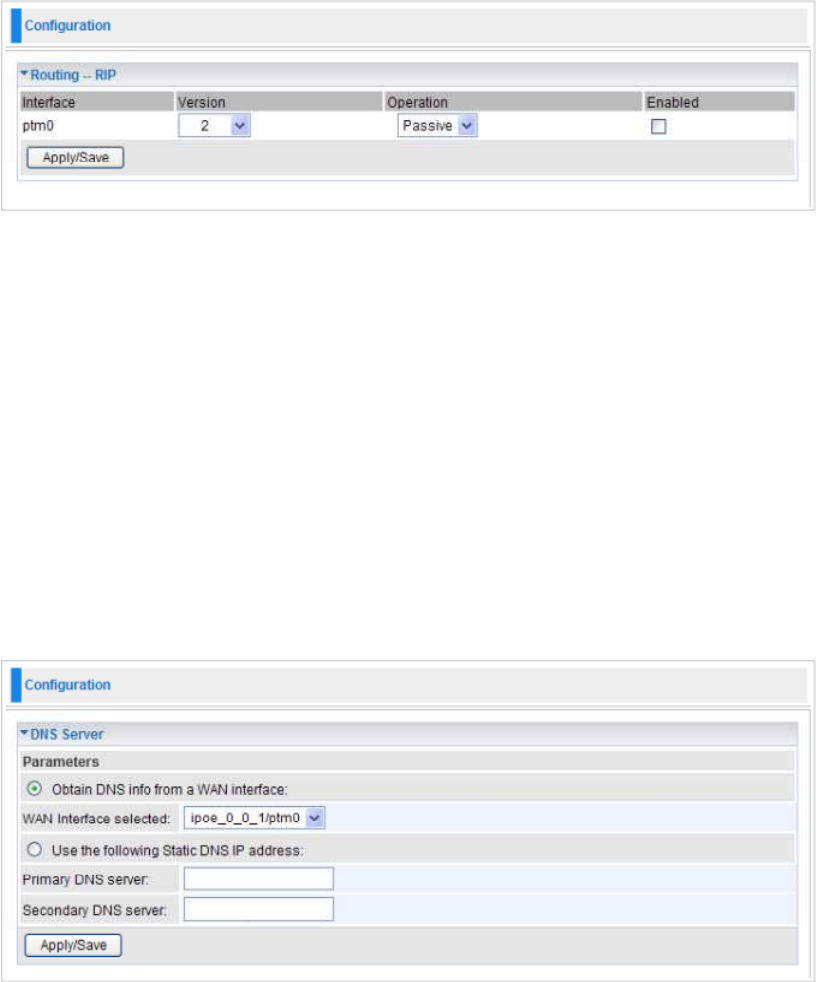
60
Interface: Select an appropriate interface for the new routing rule from the drop-down menu.
Click Add to confirm the settings.
#: This is the rule number for each static router entry.
Edit: Check the Edit radio button to display the parameters of the selected application. Then change the
items you want and click on Edit button to apply the changes.
Remove: To delete a static route entry, check the Remove box of the selected entry and then click on
Remove button.
RIP
Interface: Displays the interface for the RIP rule.
Version: Select the desired RIP version for this interface.
Gateway: Select the desired RIP operation for this interface.
Enabled: Check Enabled check box for the interface.
Click Apply/Save to confirm the settings.
DNS
DNS Server
On the Internet, Domain Name System (DNS) servers are used to translate a hostname or a domain
name to its corresponding binary identifier.
If you check "Obtain DNS info from a WAN interface", this router will accept the first received DNS
assignment from one of the WAN interface during the connection establishment. If you check "Use the
following Static DNS IP address", enter the primary and optional secondary DNS server IP addresses.
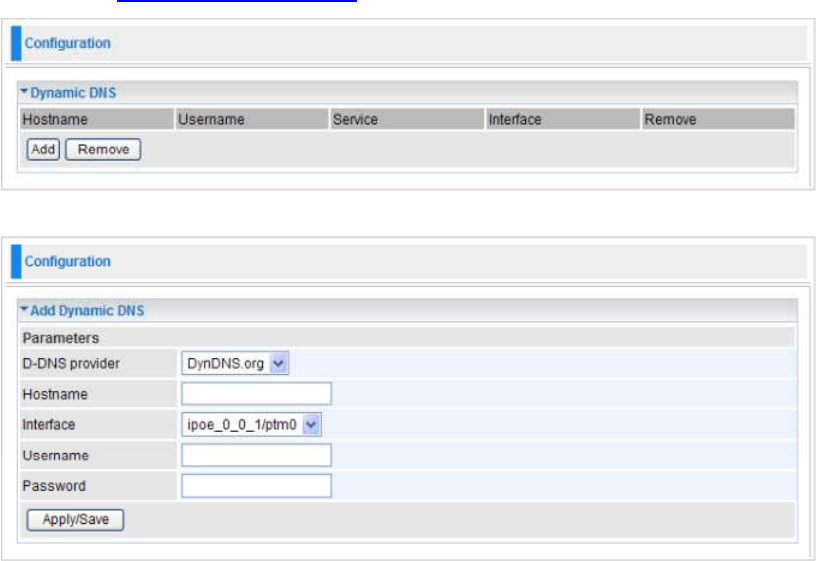
61
Click Apply/Save to confirm the settings.
Dynamic DNS
The Dynamic DNS function lets you alias a dynamic IP address to a static hostname, so if your ISP does
not assign you a static IP address you can still use a domain name. This is especially useful when
hosting servers via your ADSL connection, so that anyone wishing to connect to you may use your
domain name, rather than the dynamic IP address which is assigned to you by ISP.
You need to first register and establish an account with the Dynamic DNS provider using their website,
for example http://www.dyndns.org/.
Click Add to enter Add Dynamic DNS screen.
Dynamic DNS Server: Select the DDNS service you have registered an account with.
Hostname: Enter your registered hostname for this service.
Interface: Select an appropriate interface for the DDNS service from the drop-down menu.
Username/Password: Enter username and password for this service.
Click Apply/Save to confirm the settings and you will be returned to Dynamic DNS table.
Remove: To delete the DDNS entry from the table, check Remove checkbox then click Remove button
to delete the selected item.
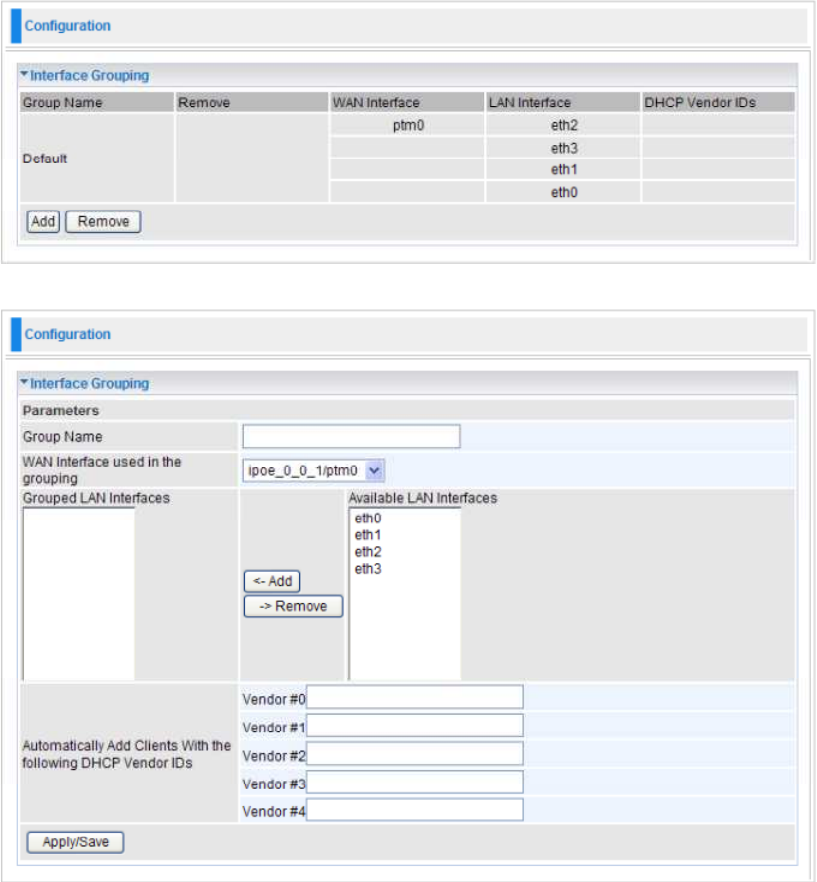
62
Interface Grouping
This function allows you to set new interfce group.
Click Add to create a new interface grouping.
Group Name: Enter the name that you want this interface group to have.
WAN Interface used in the grouping: Select appropriate WAN interface.
Grouped LAN Interfaces: Displays the list of selected ethernet ports in this group. To delete services
from the list, select the interface and click Remove.
Available LAN Interfaces: Displays the list of available ethernet ports which you can add to this group.
Select the services you want and click Add.
Note: Ethernet port needs to be part of port mapping group and bridge interface.
Automatically Add Clients With the following DHCP Vendor IDs: Enter the IDs in the fields.
Click on Save/Apply button to finish the configuration and you will be returned to Interface Grouping
table.

63
Remove: To delete the Interface Grouping from the table, check Remove checkbox then click Remove
button to delete the selected item.
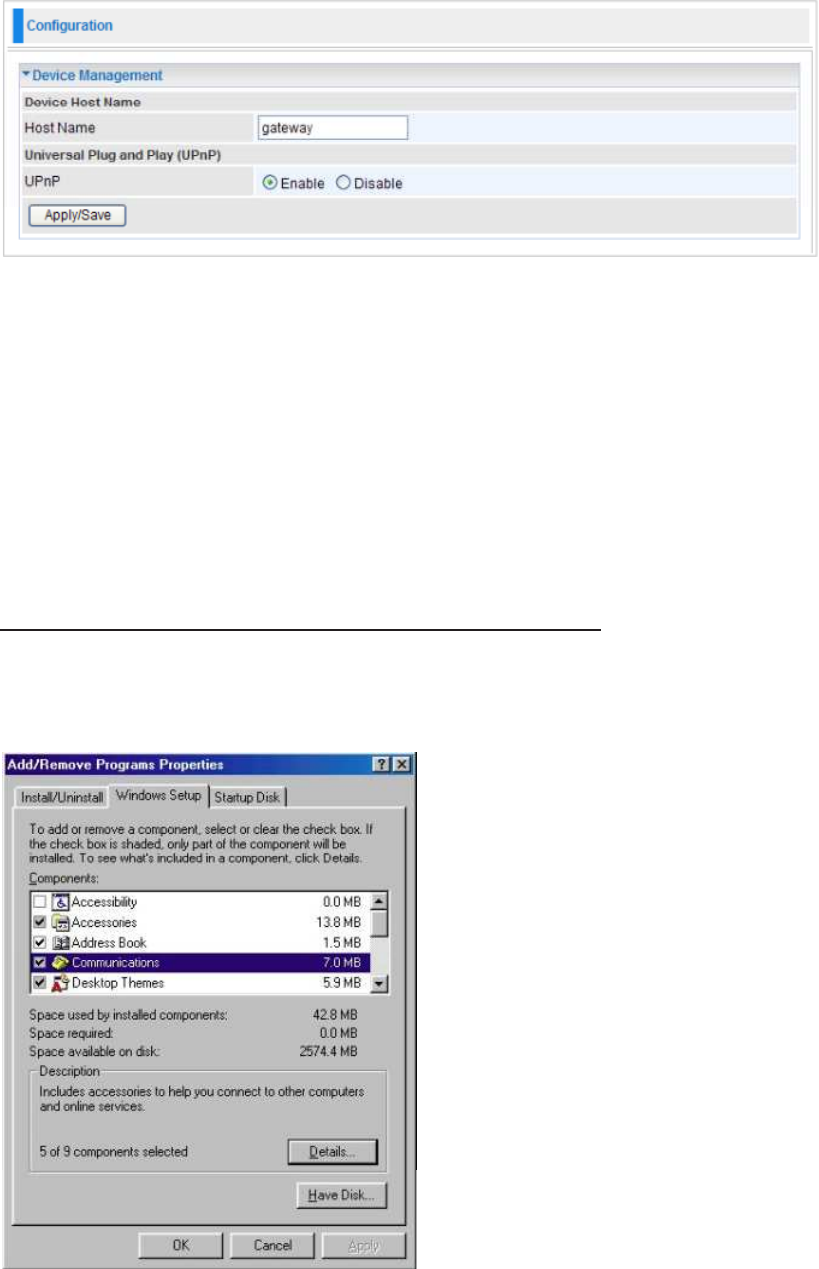
64
Device Management
The Device Management advanced configuration settings allow you to control your router’s security
options and device monitoring features.
UPnP offers peer-to-peer network connectivity for PCs and other network devices, along with the feature
to control data transfer between devices. UPnP offers many advantages for users running NAT routers
through UPnP NAT Traversal, and on supported systems. By letting the application control the required
settings and removing the need for the user to control the advanced configuration of their device will
make tasks such as port forwarding become easier.
Both user’s Operating System and its relevant applications must support UPnP in addition to the router.
Windows XP and Windows Me have a native built-in support for UPnP (when the component is installed).
Windows 98 users may have to install the Internet Connection Sharing client from Windows XP in order
to support UpnP feature. Windows 2000 does not support UPnP.
Installing UPnP in Windows Example
Follow the steps below to install the UPnP in Windows Me.
Step 1: Click Start and Control Panel. Double-click Add/Remove Programs.
Step 2: Click on the Windows Setup tab and select Communication in the Components selection box.
Click Details.
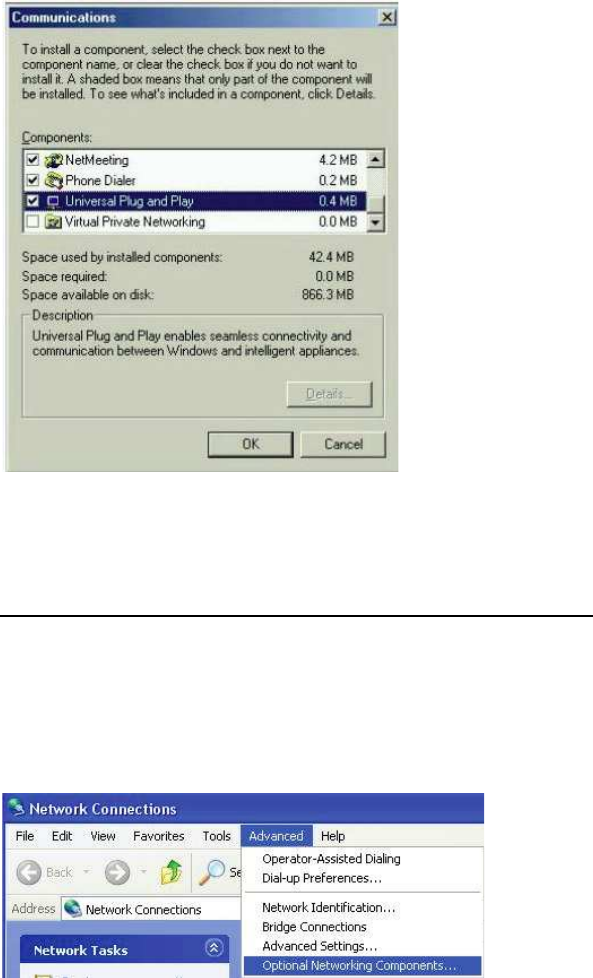
65
Step 3: In the Communications window, select the Universal Plug and Play check box in the
Components selection box.
Step 4: Click OK to go back to the Add/Remove Programs Properties window. Click Next.
Step 5: Restart the computer when prompted.
Follow the steps below to install the UPnP in Windows XP
Step 1: Click Start and Control Panel.
Step 2: Double-click Network Connections.
Step 3: In the Network Connections window, click Advanced in the main menu and select Optional
Networking Components …
Step 4: When the Windows Optional Networking Components Wizard window appears, select
Networking Service in the Components selection box and click Details.
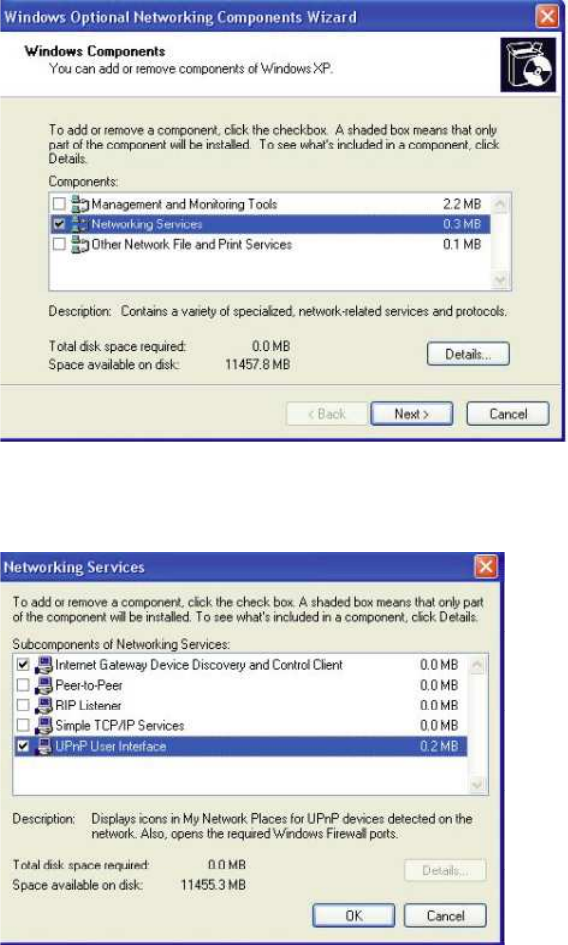
66
Step 5: In the Networking Services window, select the Universal Plug and Play check box.
Step 6: Click OK to go back to the Windows Optional Networking Component Wizard window and click
Next.
Auto-discover Your UPnP-enabled Network Device
Step 1: Click start and Control Panel. Double-click Network Connections. An icon displays under Internet
Gateway.
Step 2: Right-click the icon and select Properties.
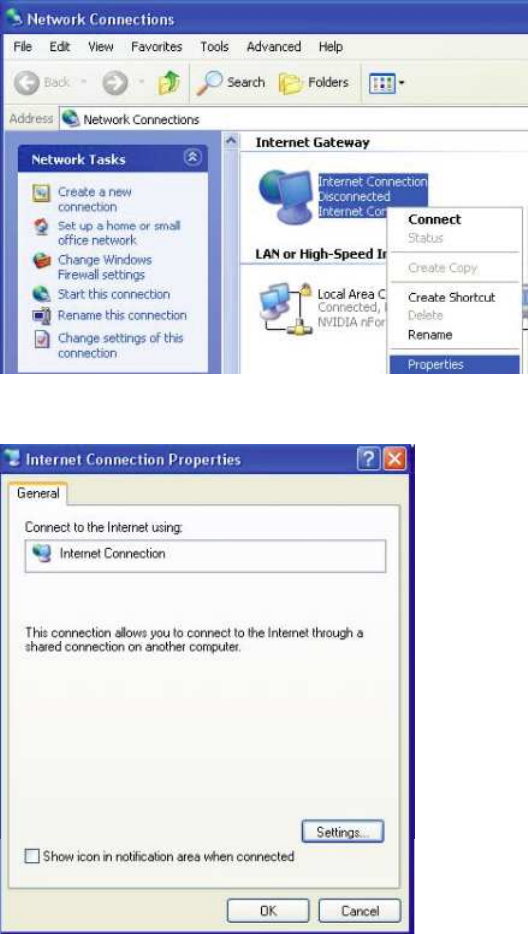
67
Step 3: In the Internet Connection Properties window, click Settings to see the port mappings that were
automatically created.
Step 4: You may edit or delete the port mappings or click Add to manually add port mappings.
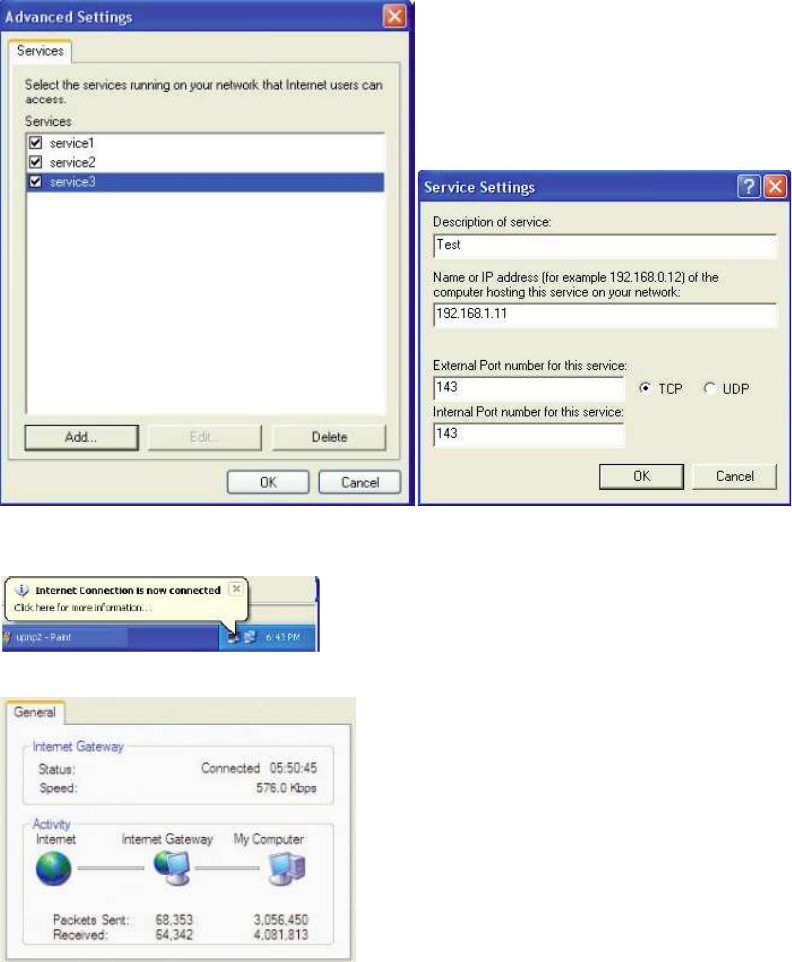
68
Step 5: Select Show icon in notification area when connected option and click OK. An icon displays in the
system tray.
Step 6: Double-click on the icon to display your current Internet connection status.
Web Configurator Easy Access
With UPnP, you can access web-based configuration for the BEC 8800N without first finding out the IP
address of the router. This helps if you do not know the router’s IP address.
Follow the steps below to access web configuration.
Step 1: Click Start and then Control Panel.
Step 2: Double-click Network Connections.
Step 3: Select My Network Places under Other Places.
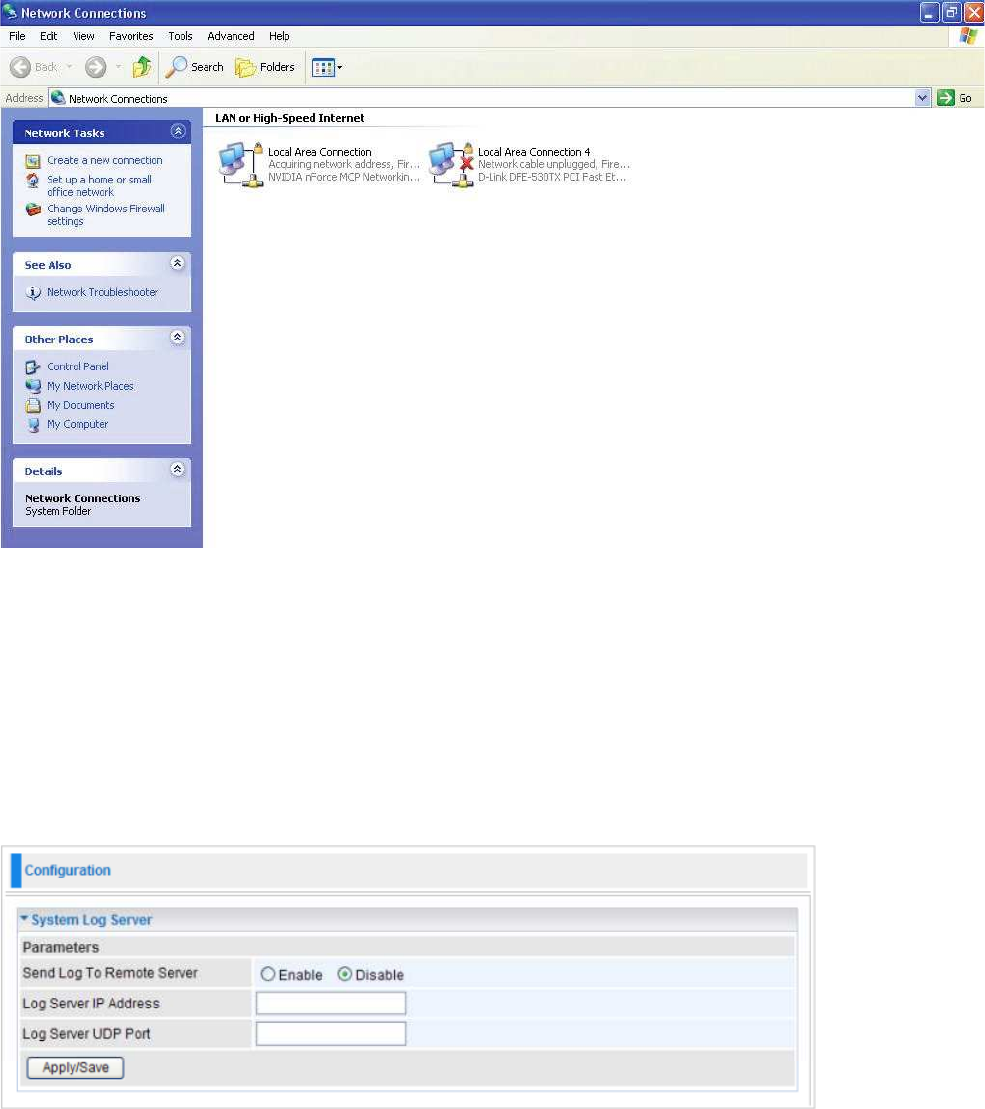
69
Step 4: An icon describing each UPnP-enabled device shows under Local Network.
Step 5: Right-click on the icon of your BEC 8800N and select Invoke. The web configuration login screen
displays.
Step 6: Right-click on the icon of your BEC 8800N and select Properties. A properties window displays
basic information about the BEC 8800N.
System Log Server
This screen allows you to view the system events log or to configure the system log options.
Send Log To Remote Server: By default, it is disabled. To enable it, tick Enable to activate system log.
Log Server IP Address: Enter the server IP address.
Log Server UDP Port: Enter the server UDP port.
Click Apply/Save to confirm the settings.
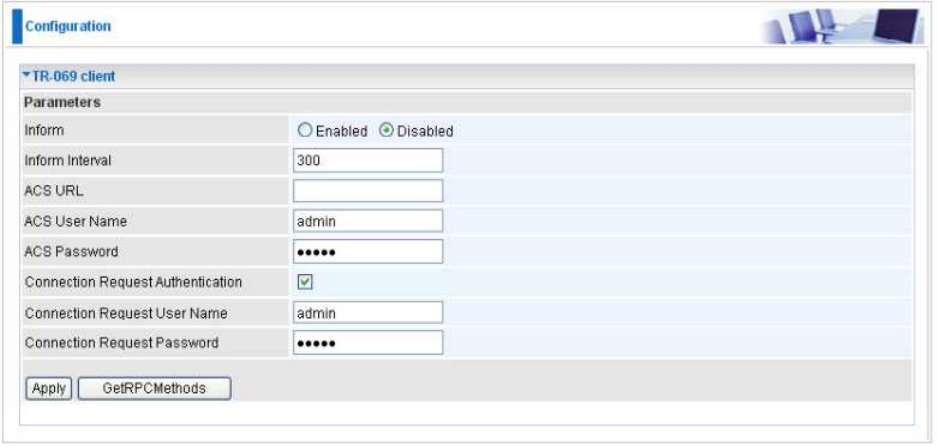
70
TR-069 Client
Please contact your ISP for the information of TR069.
Inform: You can enable or disable the periodic inform feature.
Inform Interval: Enter the length of the periodic inform interval (unit: seconds).
ACS URL: Enter the ACS URL address.
ACS Username: Enter the ACS server login name.
ACS Password: Enter the ACS server login password.
Connection Request Authentication: Check to enable connection request authentication feature.
Connection Request User Name: Enter the username for ACS server to make connection request.
Connection Request Password: Enter the password for ACS server to make connection request.
GetRPCMethods: Detect the types of methods that ACS supports and is in communication with.
Click Apply to confirm the settings.
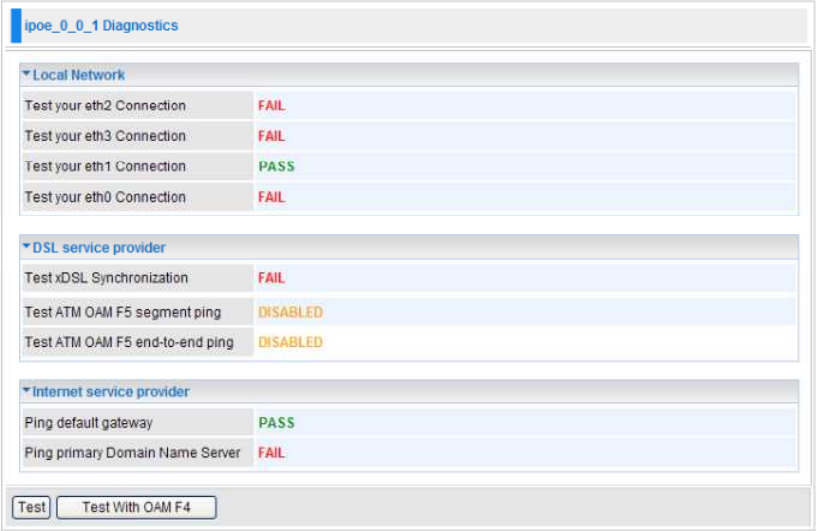
71
Diagnostics
Here are 2 items within this section: Diagnostics and Fault Management.
Diagnostics
This page allows users to test the Ethernet port connection, DSL port connection, and connection to the
Internet Service Provider. If a test displays a FAIL status, click "Test" again or "Test With OAM F4" to
make sure the fail status is consistent.
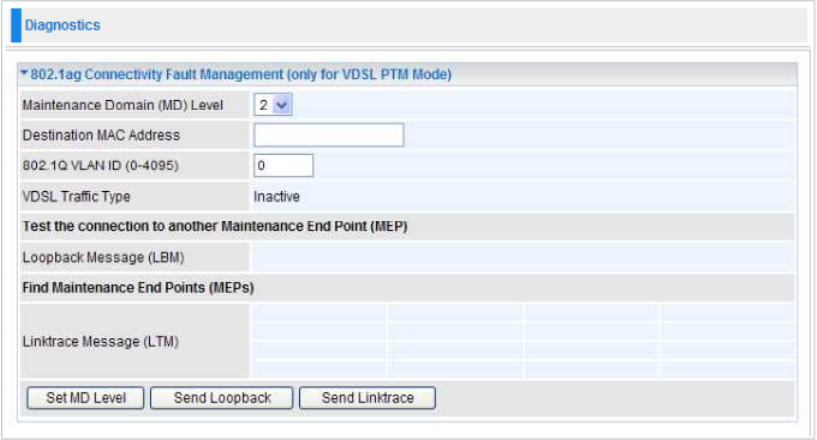
72
Fault Management
IEEE 802.1ag Ethernet Connectivity Fault Management protocols comprise three protocols: continuity
check, link trace and loopback protocols that work together to help administrators debug Ethernet
networks. On this screen, you can configure 802.1ag CFM and use this function.
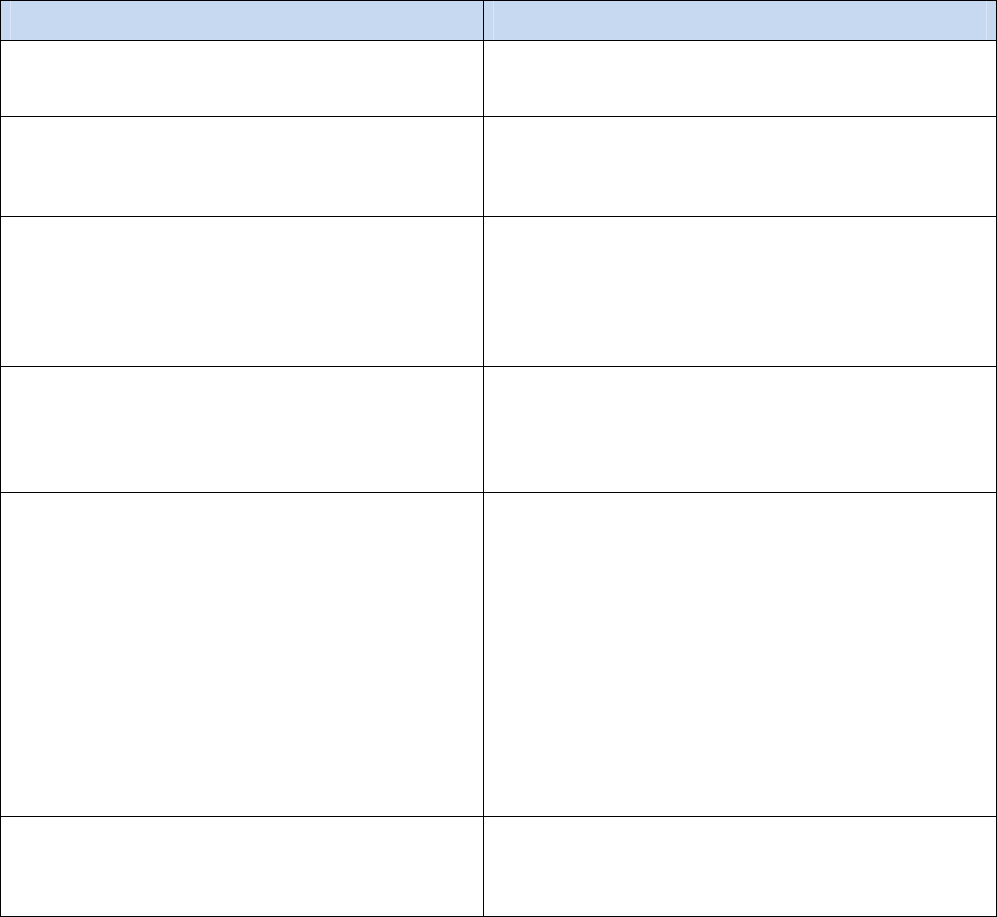
73
Chapter 5: Troubleshooting
If your router is not functioning properly, please refer to the suggested solutions provided in this chapter.
If your problems persist or the suggested solutions do not meet your needs, please kindly contact your
service provider or BEC for support.
Problem Suggested Action
The power LED is not on Make sure the connection of power supply is good,
the switch of power supply is turned on and the
output of power supply is correct.
None of the LEDs lit when the router is
turned on
Check the connection between the router and the
adapter. If the problem persists, most likely it is due
to the malfunction of your hardware. Please contact
your service provider or BEC for technical support.
I cannot access Internet or remote networks Make sure that the power is turned on and the
software configuration of the router is correct.
Ensure that the device has been restarted after
configuration change. Check IP connection using
ping command and that the DNS of the computer is
correct.
I cannot access some web server This problem is often caused by one of the following
issues:
• The MTU of operating system might be too large.
• Some operating systems might need to be
patched.
I cannot log on to the configuration page • Check the connection between the PC and the
router.
• Ensure your PC’s IP address is on the same
subnet as the router.
• Check to see if your browser has Java, JavaScript,
or ActiveX enabled. If you are using Internet
Explorer, click Refresh to ensure that the Java
applet is loaded.
• Make sure you are using the correct user name
and password. User names and passwords are
case sensitive, so make sure that CAPS LOCK is
not on when entering this information.
• Reset the device.
I have forgotten my login username or
password
Try the default username & password (Please refer
to Chapter 3). If this fails, restore your router to its
default setting by pressing the Reset button for 3~5
seconds.
74
Appendix: Product Support & Contact
If you come across any problems please contact the dealer from where you purchased your
product.
Contact BEC
http://www.bectechnologies.net
FCC Caution:
Any Changes or modifications not expressly approved by the party responsible for compliance could void the user's authority
to operate the equipment.
This device complies with part 15 of the FCC Rules. Operation is subject to the following two conditions:
(1) This device may not cause harmful interference, and
(2) this device must accept any interference received, including interference that may cause undesired operation.
IMPORTANT NOTE:
FCC Radiation Exposure Statement:
This equipment complies with FCC radiation exposure limits set forth for an uncontrolled environment .This equipment should be
installed and operated with minimum distance 20cm between the radiator& your body.
This transmitter must not be co-located or operating in conjunction with any other antenna or transmitter.
Note: This equipment has been tested and found to comply with the limits for a class B digital device,pursuant to part 15 of the FCC
rules.This limits are designed to provide reasonable protection against harnful interenference in a residential installation . this
equipment generates ,uses and can radiate radio frequency energy and ,if not installed and used in accordance with the instructions
may case harmful interference to radio communication.However, there is no grantee will not occur in a particular installation.If this
equipment doses cause harmful interference to radio or television reception ,which can be determined by turning the equipment off
and on , the user is encourage to try to correct the interference by one or more of the following mersures:
-Reorient or relocate the receiving antenna.
-Increase the separation between the equipment and receiver.
-Connect the equipment into an outlet on a circuit different from that to which the receiver is connected.
-Consult the dealer or an experienced radio/TV technician for help.
Customer Information
1.This equipment complies with Part 68 of the FCC rules and the requirements adopted by the ACTA. On the bottom of this
equipment is a label that contains, among other information, a product identifier in the format US:AAAEQ##TXXXX. If requested,
this number must be provided to the telephone company.
2.A plug and jack used to connect this equipment to the premises wiring and telephone network must comply with the applicable
FCC Part 68 rules and requirements adopted by the ACTA. A compliant telephone cord and modular plug is provided with this
product. It is designed to be connected to a compatible modular jack that is also compliant. See installation instructions for details.
3.If this equipment [US: B12DL01B8920NE] causes harm to the telephone network, the telephone company will notify you in advance
that temporary discontinuance of service may be required. But if advance notice isn't practical, the telephone company will notify
the customer as soon as possible. Also, you will be advised of your right to file a complaint with the FCC if you believe it is necessary
4.The telephone company may make changes in its facilities, equipment, operations or procedures that could affect the operation
of the equipment. If this happens the telephone company will provide advance notice in order for you to make necessary
modifications to maintain uninterrupted service.
5.If trouble is experienced with this equipment [US: B12DL01B8920NE], for repair or warranty information, Service can be facilitate
d through our office at:
U.S. Agent Company name:BEC Technologies Inc.
Address:1500 Precision Drive, Suite 100 Plano TX 75074 USA
Tel:+1-972-422-0877
If the equipment is causing harm to the telephone network, the telephone company may request that you disconnect the equipment
until the problem is resolved.
6.Please follow instructions for repairing if any (e.g. battery replacement section); otherwise do not alternate or repair any partsof
device except specified. For repair procedures, follow the instructions outlined under the limited warranty.
7.Connection to party line service is subject to state tariffs. Contact the state public utility commission, public service commission
or corporation commission for information.
8.If your home has specially wired alarm equipment connected to the telephone line, ensure the installation of this [8920NE]
does not disable your alarm equipment. If you have questions about what will disable alarm equipment, consult your telephone
company or a qualified installer.
9.If the telephone company requests information on what equipment is connected to their lines, inform them of:
a)The ringer equivalence number[ 0.1B]
b)The USOC jack required [RJ11C]
c)Facility Interface Codes ("FIC") [METALLIC]
d)Service Order Codes ("SOC") [9.0Y]
e)The FCC Registration Numbe [US:B12DL01B8920NE]
10.The REN is used to determine the number of devices that may be connected to a telephone line. Excessive RENs on
a telephone line may result in the devices not ringing in response to an incoming call. In most but not all areas, the sum of RENs
should not exceed five (5.0). To be certain of the number of devices that may be connected to a line, as determined by the total
RENs, contact the local telephone company. The REN for this product is part of the product identifier that has the format
US:AAAEQ##TXXXX. The digits represented by ## are the REN without a decimal point. For this product the FCC Registration
number is [US: B12DL01B8920NE] indicates the REN would be 0.1.
MAC OS is a registered Trademark of Apple Computer, Inc.
Windows 7/98, Windows NT, Windows 2000, Windows Me, Windows XP and Windows Vista are registered
Trademarks of Microsoft Corporation.